English
Information
-

▼This month’s theme : New Year’s Celebration
Happy New Year!
We hope 2026 has begun beautifully for you.
At Yamashiroya Shozo, we’ve created a special January course built around the theme “New Year’s Celebration,” a fitting way to welcome the start of 2026.
To open the meal, we serve a petite osechi assortment called “Kinsho Osechi,” presented in a small wooden box — a modest yet heartfelt greeting to the new year.
Throughout the course, we’ve added ingredients traditionally associated with good fortune, such as sea bream, duck, and venison, each symbolizing our wish for your year to be peaceful and prosperous.
We invite you to celebrate the beginning of a bright new year with us at Yamashiroya Shozo.
May the coming year bring you happiness and many wonderful moments.
------------------------------------------------------------------------------
Modest Osechi:
Uncommon namasu with dried persimmon
Deep-fried herring roe on kelp
Head-on sweet shrimp marinated in Shaoxing wine
Pickled rapeseed greens in rice bran
Boiled burdock root mixed with sesame
Sweet rolled omelet in hoji-tea
Glazed ume-shaped carrot
Oshinogi:
Duck and scallion skewer
Wan-mono:
Traditional New Year’s miso soup with scallop and rice cake
Steamed Dish;
Steamed sea bream with karashi okara
finished with lightly smoked taihaku sesame oil
Kuchinaoshi:
Homemade ricotta cheese with fragrant star anise and infused kumquat
Main dish:
Roasted Ezo venison, cooked to a perfect core temperature
served with soy pickled young ginger
Shokuji:
Steamed rice with ebi-imo
Tomewan:
Mugi miso soup with fine yuzu zest
Dessert:
Hoji-tea ice cream
Burnt Basque cheesecake with black sesame
Sweet bean ball, with sweet potato and chestnut
------------------------------------------------------------------------------ -
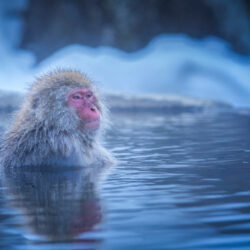
▼This month’s theme : Warm moments of winter
“Warm moments of winter” describes the gentle pockets of comfort that appear in the coldest season. This month’s menu is created to let you feel that soft warmth—short, quiet pauses of ease in the middle of winter’s chill.
We bring a playful touch to Japanese cuisine by adding subtle Christmas hints and light Western accents, shaping a relaxed and modern kuzushi style. The opening dish, a savory egg custard inspired by clam chowder, carries the aroma of bay leaf—Western warmth tucked inside a Japanese cup.
For the hassun (a seasonal tasting plate served at the start of a kaiseki meal), we add a touch of fun with items like Brussels sprouts, strawberries, and pistachios.
We close the course with simple, gently warming dishes that highlight each ingredient at its best. Join us this December for a quiet, comforting meal at Yamashiroya Shouzou. We look forward to welcoming you.
------------------------------------------------------------------------------
Sakizuke:
Steamed egg custard with clam chowder and bay leaf aroma
Wan-mono:
Snowy daikon soup with kudzu-coated oyster
Hassun:
Creamy yam with yellow chives
Pickled Brussels sprouts with olive oil
Strawberry & pistachio with white sesame cream
Salt-cured whitebait
Spinach castella
Braised amberjack and daikon
Black beans simmered in red wine with pine-needle skewer
Yaki-mono:
Grilled sesame tofu with peanut cream and ground sesame
Kuchinaoshi:
Homemade ricotta with yellow yuzu
Main dish:
Saikyo-miso grilled lamb & lamb tsukune with mashed potatoes and whey-saikyo miso
Shokuji:
Whey risotto with lotus root
Dessert:
Hoji-tea ice cream
Kappo-style sweet potato
Pumpkin terrine
------------------------------------------------------------------------------ -
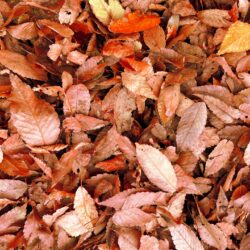
▼This month’s theme : Melancholy Fall
As the leaves turn brilliant shades of red and gold, the trees quietly begin to prepare for winter.
It is a fleeting moment between late autumn and early winter — when the vibrant colors of fall gently fade and drift away, leaving behind a wistful beauty.
This course expresses that quiet melancholy through dishes that capture the essence of the season.
For the appetizer, we offer a trio that evokes the atmosphere of late autumn:
Kelp-cured red sea bream, jellied matsutake mushrooms, and jade eggplant.
Throughout the course, autumn’s deep, earthy flavors are subtly interwoven with the first hints of winter ingredients, allowing you to experience the poetic transition of the season — the very scene of Melancholy fall — through all five senses.
Please take your time to savor this graceful moment of seasonal change in the serene ambiance of Yamashiroya Shōzō.
------------------------------------------------------------------------------
Sakizuke:
Konbu-shime of sea bream, deep-fried eggplant and jellied matsutake mushroom
Wan-mono:
“Momiji” clear chicken and bonito broth with delicate shredded vegetables
Hassun:
Boiled prawn and ginkgo nut
Crushed and pressed hard -boiled egg
Simmered fresh gluten cakes in bonito-based soup
Acorn shaped quail egg
Pine cone shaped arrowhead
Crab mixed with vinegar and estragon
Seared mackerel sushi
Castella with potato
Simmered walnut with teriyaki sauce
Age-mono:
Deep-fried yellowtail and daikon radish, served with starched apple vinegar sauce
Kuchinaoshi:
Homemade ricotta cheese with sliced pear
Main dish:
Ginger-grilled duck with marmalade XO sauce
Shokuji:
Steamed rice with Chinese cabbage and dried shrimp
Tome-wan:
Red miso soup with konjac noodle
Dessert:
Hoji-tea ice cream
Sweet bean ball with apricot
Steamed white sponge with Chinese yam
------------------------------------------------------------------------------ -

▼This month’s theme : Radiant autumn days
Among the many colors of Japan’s seasonal landscapes, autumn is often described as the season that “deepens,” carrying a quiet sense of richness.
The phrase radiant autumn days evokes clear skies, crisp air, and the gentle passing of time. At Yamashiroya Shōzō, we have prepared a menu that reflects this season’s beauty, expressing the deepening of autumn in every dish.
We begin with a refined starter: black sesame tofu blended with bamboo charcoal, accented by the sharp aroma of wasabi and adorned with golden rice stalks—an elegant taste of autumn. The soup combines seasonal pike conger, at its peak once again in autumn, with onions slowly cooked at low temperature to draw out their natural sweetness.
Throughout the menu, from grilled pacific saury to other seasonal offerings, each plate highlights the blessings of autumn and delivers a nourishing depth of flavor.
As time flows and autumn deepens, we hope you will savor its beauty and tranquility through our October menu at Yamashiroya Shōzō.
------------------------------------------------------------------------------
Sakizuke:
Black sesami tofu with bamboo charcoal, served with garnished with fried rice stalks
Wan-mono:
Bonito-based soup and grated onion soup with autumn hamo fish
Hassun:
Sashimi tuna mixed with land caviar
Castella with taro
Pickled oriental radish in rice bran
Millet wheat gluten topped with sweet white miso
Mackerel and myoga ginger dressed with peanut sauce
Fried ginkgo nut with garlic
Marinated mushroom with truffle
Steamed rice and beef wrapped in a bamboo mat
Age-mono:
Deep-fried tilefish and fig, served with starched white wine and soy sauce
Kuchinaoshi:
Homemade ricotta cheese with apple vinegar and sake lees
Main dish:
Venison and potato stew
Shokuji:
Steamed glutinous brown rice with seared pacific saury with liver soy sauce
Tome-wan:
Wheat miso soup with Japanese chervil
Dessert:
Hoji-tea ice cream
Brandy-infused Mont Blanc with sweet red bean
Persimmon jelly with amaretto
------------------------------------------------------------------------------ -

▼This month’s theme : The lingering nights of autumn
The expression “lingering nights of autumn” captures not only the longer evenings compared with summer, but also the quiet melancholy and gentle moments of reflection that deepen as the season advances.
Although the lingering summer heat still remains in September, at Yamashiroya Shōzō we hope that, at least during your dining experience, you may feel the serenity of an autumn evening. For this reason, the September menu has been prepared under the theme the lingering nights of autumn.
The meal begins with sea bream, at its seasonal peak of richness, prepared as matsukawa-zukuri and accompanied by a sauce of nori and olives—an inventive dish in the Yamashiroya style.
From the opening appetizer to the final dessert, the menu is composed with an abundance of seasonal ingredients, crafted to evoke autumn fully and leave behind the lingering notes of summer.
We invite you to enjoy a dining experience at Yamashiroya Shōzō that allows you to savor the essence of the lingering nights of autumn.
Late Summer Breeze
------------------------------------------------------------------------------
Sakizuke:
Lightly seared sea bream with skin, served with nori and black olive sauce
Wan-mono:
Clear seafood soup with tempura of fresh ginger and Kujo scallion
Hassun:
Fried ginkgo nuts with pine needle
Pickled daikoku mushrooms in rice bran
Seared vinegared mackerel with chrysanthemum
Chestnut simmered in brandy syrup
Grilled persimmon with prosciutto
Jade eggplant sushi
Fig castella with Saikyo miso
Age-mono:
Bonito in red shiso coating sandwich
Kuchinaoshi:
Olive oil sorbet
Main dish:
Refined pork miso soup, Yamashiroya style
Shokuji:
Steamed rice with dried enoki mushrooms and ginger
Tome-wan:
Served with red miso soup and green chili
Dessert:
Hoji-tea ice cream
Matcha baked cheesecake
Black sesame sweet bean ball
------------------------------------------------------------------------------
-

▼This month’s theme : Late Summer Breeze
Our July theme is "Late Summer Breeze" "Byoka" is a poetic word for the end of summer, when hints of autumn start to creep in after Obon. While the calendar marks the start of fall, this period is still marked by lingering summer heat.
This month at Yamashiroya Shouzou, we’ve crafted a course menu that embraces the essence of byoka—designed to energize your body through the last stretch of summer. We've infused seasonal vegetables and seafood with flavors that awaken the appetite.
The course begins with a chilled somen noodle dish, paired with fresh abalone—an elegant start to a summer meal. The soup features hamo, a Kyoto summer classic, prepared with a spicy twist. For the main course, we highlight a vibrant array of summer vegetables.
Enjoy a menu with Yamashiroya’s signature creative flair, and let the fleeting charm of late summer linger on your palate.
------------------------------------------------------------------------------
Sakizuke:
Chilled somen noodles with abalone and rich liver dashi
Wan-mono:
Spicy tomato broth with parboiled hamo (pike conger) and winter melon
Hassun:
Sweet-pickled cherry tomato in a ground cherry cup
Bitter melon pickled in rice bran
Edamame with a touch of fermented bonito
Sweet corn castella cake
Brandy-simmered sweet potato
Boiled peanuts
Crispy fried hamo with vinegared cucumber
Ni-mono:
Hamo sukiyaki simmered in a Japanese curry broth
Kuchinaoshi:
Celery sorbet
Main Course
Summer vegetable miso ratatouille with shotturu-seasoned Shingen chicken
Shokuji:
Hamo tempura rice bowl with yuzu soy glaze
Tome-wan:
Clear soup with hamo liver and swim bladder
Dessert:
Hoji-tea ice cream
Ginger jelly
Shikwasa citrus sweet bean jelly
------------------------------------------------------------------------------
-

▼This month’s theme : The Hamo Fish Course.
Our July theme is " The Hamo Fish Course." A summer in Kyoto would not be complete without "hamo" (conger eel). In the old days, obtaining fresh fish in the central part of Kyoto, located inland, was quite challenging. Only the hardy hamo could survive the poor transportation conditions and be delivered live to Kyoto. However, the hamo has many small bones and cannot be eaten as it is. Therefore, ancient chefs invented a cooking method called "honekiri," where they make 26 cuts per inch, making it possible to eat the bony hamo. Hamo prepared using this traditional cooking method is simply exquisite.
At Yamashiroya Shozo, a Kyoto-style kaiseki restaurant, we have prepared a menu in August that allows you to enjoy hamo in various ways, including honekiri hamo, hamo eggs, bones, and the rich broth that can be extracted from them.
It is undeniably a “Hamo Feast." Come and enjoy the unique and creatively arranged hamo dishes that only Yamashiroya Shozo can offer.
We also have a large selection of specially imported Italian wines to accompany our dishes and offer takeout and delivery menus. We believe you will find our restaurant to be an ideal location for dining with friends, family or colleagues.
We look forward to your visit.
------------------------------------------------------------------------------
The Hamo Fish Course
Sakizuke:
Seared hamo with grilled peach sauce and charcoal salt
Wan-mono:
Hamo dashi broth with sesame tofu and fried Manganji pepper
Hassun:
Pickled winter melon in rice bran
Crispy hamo bone crackers
Hamo roe and couscous tamago-jime with mitsuba herb
Fried hamo with vinegared cucumber
Pumpkin castella cake
Pickled young ginger with sansho pepper
Chilled molokhia soup
Age-mono:
Hamo tempura with curry salt and crunchy ume plum
Kuchinaoshi:
Celery sorbet
Main dish:
Simmered pork cubes with fig tempura
Shokuji:
Steamed rice with grilled hamo and corn, finished with melted butter
Tome-wan:
Hamo liver clear soup
Dessert:
Hoji-tea ice cream
Cream cheese yokan with raisins
Pickled tomato with peach liqueur
------------------------------------------------------------------------------
-

▼This month’s theme : “Minazuki” Grace of the rainy season
Minazuki: Grace of the rainy season
In the old Japanese calendar, Minazuki refers to the sixth month—June. Although the characters mean “month without water,” this is ironically the season of heavy rain. In fact, the rains are essential for rice cultivation, and some believe the name originally meant “the month of water” (mizu no tsuki) in classical Japanese.
June also marks the halfway point of the year. Traditionally, it’s a time for Nagoshi no Harae, a purification ritual to cleanse the body and spirit of impurities from the past six months and to pray for good health and protection for the rest of the year.
This month's seasonal course is inspired by the symbols of early summer—hydrangeas in bloom, gentle rains, and time-honored rituals. You’ll find dishes that reflect these elements: like Minazuki Tofu, a traditional food for the purification rite, and Ajisai Wan, a soup inspired by the delicate beauty of hydrangeas.
We invite you to experience the June course “Minazuki” at Yamashiroya Shouzou and savor the taste of this quietly powerful season.
------------------------------------------------------------------------------
Sakizuke:
A smooth tofu dish, served with a decorative nod to purification rituals
Wan-mono:
A poetic hydrangea soup, delicately infused with purple cabbage」
Hassun:
Potato castella
Malabar spinach tossed with blue cheese
Crispy-fried Chinese pickled shallots
Asparagus pickled in rice bran
Tempura of bitter melon
Seared skipjack tuna, smoked with Kyoto-style roasted tea
Grilled young burdock root steeped in dashi
Simmered dish:
Slow-simmered octopus with seasonal vegetables in chilled broth, served with green vinegar sauce
Kuchinaoshi:
Homemade ricotta with spiced pineapple
Main dish:
Cold pork shabu-shabu, styled like flat kishimen noodles
Shokuji:
Anchovy hiyajiru – a chilled savory broth poured over rice with fragrant summer herbs
Dessert:
Hoji-tea Ice Cream
Caramelized summer orange
Sweet bean ball, crafted in the image of Minazuki tofu
------------------------------------------------------------------------------
-

▼This month’s theme : A season born on fragrant winds
As the fresh greenery flourishes and the breeze carries the scent of young leaves, May arrives, known as the season of fragrant winds.
This month at Yamashiroya Shouzou, we celebrate this fleeting beauty with a special course themed around "fragrance," using the finest seasonal ingredients to evoke the freshness and aromas of early summer.
To open the course, we present seasonal bonito, delicately smoked over Kyoto bancha tea, offering a vibrant yet gentle start filled with aromatic richness.
Throughout the course, we weave in fragrant ingredients essential to Japanese cuisine — such as wasabi, kinome (young sansho leaves), and sansho pepper — while also embracing aromatic elements beyond tradition, bringing a relaxed yet refined touch unique to Yamashiroya Shouzou.
Come and experience a season born on fragrant winds, through a menu that captures the spirit of early summer.
------------------------------------------------------------------------------
Sakizuke:
Smoked bonito with the fragrance of Kyoto bancha tea
Wan-mono:
Green pea sesame tofu in creamy bonito-based soup
Hassun:
Smoked salmon and lotus root layered delicacy
Young sweetfish with water pepper sauce
Taro stem dressed in sesame sauce
Pickled shallot in rice bran
Pickled myoga ginger in sweet vinegar
Fried broad beans and shrimp skewers
Edamame castella cake
Yakimono:
Slow-roasted fermented onion
Kuchinaoshi:
Homemade ricotta cheese with kiwi
Main dish:
Braised Chami pork wrapped like a kashiwa-mochi
Shokuji:
Fragrant sansho pilaf with kinome leaves
Tome-wan:
Red miso soup with molokhiya
Dessert:Hoji-tea ice cream
Light steamed matcha and yam cake
Young peach compote with amaretto
------------------------------------------------------------------------------
-
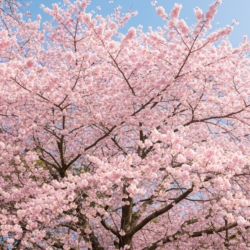
▼This month’s theme : News from the Blossoms
News from the Blossoms
In Japan, hanadayori means "news from the blossoms"—a poetic sign that spring has truly arrived. Inspired by this gentle message from nature, we’ve created a special course at Yamashiroya Shouzou to celebrate the beauty of the season.
You’ll find dishes that feature sakura blossoms, as well as ingredients with “sakura” in their name and other handpicked seasonal flavors. Every plate is designed to let you savor the full bloom of spring.
We hope this “News from the Blossoms” from our kitchen brings a touch of spring to your table—and to your heart.
------------------------------------------------------------------------------
Sakizuke :
Sakura sesame tofu resting on a silky mugwort cream
Wan-mono:
Mekabu in warm bonito-based soup with crispy fried grated yam and ginger ribbons
Hassun:
Jade-green simmered green peas
Sakura-braised octopus
Burdock root castella cake
Pickled warabi fern in rice bran
Spring greens and wasabi leaves with egg yolk vinegar sauce
Spring udo tossed with kinome miso
Sushi styled like sakura mochi with olive oil
Yakimono:
Sakura trout yūan-style with wasabi leaf tartar
Kuchinaoshi:
House-made ricotta cheese with sweet summer citrus
Main dish:
Sakura horse meat two ways with onion and grain mustard
Shokuji:
Steamed rice with bamboo shoots and sakura shrimp
Soup:
Red miso soup with spring cabbage and black shichimi pepper
Dessert:
Hoji-tea ice cream
Sweet bean ball with salted sakura petals and butter
Matcha jelly with a hint of juniper berry
------------------------------------------------------------------------------
-

▼This month’s theme : Spring Awakening
Embrace the end of winter with the gentle warmth of a new season. Our “Spring Awakening” course celebrates nature’s revival and offers a culinary journey that captures the essence of spring.
For the appetizer, delight in a dish featuring fresh wakame paired with tender bamboo shoots—artfully reimagined with the playful twist that defines Yamashiroya Shōzō.
Even though March may still be chilly, our generous use of seasonal, foraged wild greens transforms your dining experience into a true taste of spring.
Join us for our March seasonal course, “Spring Awakening,” and savor the subtle transition of the seasons. We eagerly await your visit.
------------------------------------------------------------------------------
Spring Awakening
Sakizuke:
Deep-fried wakame seaweed and bamboo shoots, served with vinegar miso espuma
Wan-mono:
Bonito-based soup with grilled fresh onion and crown daisies paste
Hassun:
Jellied consommé with cod roe and coriander
Castella cake infused with rapeseed blossoms
Seaweed roll with jellyfish and Kyoto mustard greens
Sea bream sashimi with salt and lemon
Boiled firefly squid mixed with Mitsuba
Pickled broccoli in rice bran
Tara shoot tempura with plum salt
Yakimono:
Grilled spanish mackerel marinated in saikyo miso, served with couscous
Kuchinaoshi:
House-made ricotta cheese with parsley and olive oil
Main dish:
Water dropwort and pork cutlet with simmered eggs, served on a ceramic plate
Shokuji:
Udo wild vegetables Infused Steamed Rice with Clam Tsukudani
Toiwan:
Red miso soup with deep-fried butterbur sprouts
Dessert:
Hoji-tea Ice Cream
Mugwort sweet Bean ball
Almond jelly with anise-scented goji berries
------------------------------------------------------------------------------
-

▼This month’s theme : Seasonal Delights of February
February might be the shortest month of the year, but it’s packed with events that let you savor the season.
This month, we’ve crafted a special course themed around “Seasonal Delights of February” From symbolic dishes for Setsubun to Inari sushi celebrating Hatsu-uma (the first horse day of February in the lunar calendar), and even a creative twist on the classic Ehomaki with unique Yamashiroya Shōzō flair, we’ve blended tradition with playful innovation. To add a modern touch, we’ve also included a nod to Valentine’s Day, making this course as fun as it is delicious.
Don’t let February slip away too quickly—immerse yourself in the flavors of “Seasonal Delights of February” at Yamashiroya Shōzō. We can’t wait to welcome you!
------------------------------------------------------------------------------
Seasonal Delights of February
Sakizuke Hassun:
Setsubun fortune beans
Sweetened pickled lotus root with mortadella
Plum wheat gluten stewed in plum sauce
Cauliflower castella cake
Deep-fried Japanese round herring
Marinated Kujo scallion in rice bran
Oshinogi:
Hatsuuma black inari sushi served with pickled ginger and kombu
Wan-mono:
Bonito-based miso soup and mandarin orange, with sesame tofu
Agemono:
Crispy panko-crusted sea bream, served with grated daikon and mashed chrysanthemum greens
Kuchinaoshi:
House-made ricotta cheese with hassaku orange
Main dish:
Whale tataki wrapped with a trio of condiments
Shokuji:
Crumbled ehomaki sushi roll with black beans stewed in red wine
Dessert:
Hoji-tea ice cream
Traditional Japanese sweet bean jelly with coffee
Silky Smooth Ganache with sake lees
------------------------------------------------------------------------------
-

▼This month’s theme : New Year’s Blessings
Happy New Year!
I hope you are all enjoying a wonderful start to the new year.
For the January menu at Yamashiroya Shozo, we’ve created a special course that fits the spirit of 2025, with a theme of "New Year's Blessings."
To kick off the course, we’ve prepared a small box of osechi, symbolizing the traditional New Year dishes, in a tiny paulownia wood box—this is our "Modest Osechi."
We’ve also included special ingredients like abalone, venison, and fugu (pufferfish), all symbols of good luck, to wish you a smooth and prosperous year ahead.
Why not start your year on a lucky note with us at Yamashiroya Shozo?
Wishing you a year full of happiness and success from the bottom of my heart!
Additionally, we offer a wide selection of our own imported Italian wines that pair perfectly with the menu. Whether you're dining with family and friends, or hosting a business meal, we believe you'll be completely satisfied. We sincerely look forward to welcoming you to our restaurant.
------------------------------------------------------------------------------
Modest Osechi:
Uncommon namasu with dried persimmon
Deep-fried herring roe on kelp
Marinated fish cake in rice bran
Boiled burdock root mixed with sesame
Sweet rolled omelet in hoji-tea
Oshinogi:
Abalone sashimi and liver seaweed sauce, served with sticky rice
Wan-mono:
Traditional New Year’s miso soup with scallop and rice cake
Agemono:
Deep-fried sea bream and ebi-imo, served with yuzu citron and miso
Kuchinaoshi:
Homemade ricotta cheese with golden kiwi
Main dish:
Roasted venison, served with marinated ginger in soy sauce
Shokuji:
Steamed rice with blowfish and black beans
Tomewan:
Red miso soup with Japanese parsley
Dessert:
Hoji-tea ice cream
Burnt Basque cheesecake with black sesame
Sweet bean ball, with sweet potato and chestnut
------------------------------------------------------------------------------
-

This month’s theme : Yuzu Hiyori
December is the month of the winter solstice.
This is the day on which winter arrives, beyond which the cold enters in earnest and the season changes to winter.
It is also a day symbolizing the turning of fortunes and the start of a new cycle.
“Yuzu Hiyori” is the theme of our menu featuring yellow yuzu citrus, an auspicious and indispensable item on the winter solstice that marks the start of lengthening days.
Please enjoy our December “Yuzu Hiyori” menu's plentiful and auspicious yellow yuzu, skin and pulp, in dishes from appetizer to dessert.
As the calendar draws to its end, it's time to look back on the year that was.
Come and spend the winter solstice preparing to greet the new year with Yamashiroya Shozo's “Yuzu Hiyori” menu.
We also have a large selection of specially imported Italian wines to accompany our dishes and offer takeout and delivery menus. We believe you will find our restaurant to be an ideal location for dining with friends, family or colleagues.
We look forward to your visit.
------------------------------------------------------------------------------
Yuzu Hiyori
Sakizuke:
Yellowtail sashimi and Syogoin daikon, served with basket made of yuzu
Wan-mono:
Grated shogoin turnip in bonito-based soup with oyster and sesame tofu
Hassun:
Chinese yellow chives
Marinated lotus root in rice bran
Sushi tsubaki
Strawberry and pistachio mixed with sesame cream sauce
Deep-fried Japanese pond smelt with thinly sliced daikon radish
Braised beef tendon with bean curd skin and wasabi
Salted Japanese ice fish
Castella with spinach
Nimono:
Steamed egg custard with clam chowder
Kuchinaoshi:
Homemade ricotta cheese with yuzu
Main dish:
Chicken sukiyaki flavored with yuzu
Shokuji:
Ochazuke with sea bream and crushed garland chrysanthemum
Dessert:
Hoji-tea ice cream
Japanese sweet potato
Sweet bean ball with yuzu
-

This month’s theme : Melancholy fall
The menu theme for November is Irohachiru (how leaves turn color and fall).
Leaves are turning colors and trees are getting ready for winter.
We came up with this menu to impressively express the sadness and a sense of longing in late fall when colorful leaves fall in a season from late fall to early winter, a period when trees go through changes
For the appetizer, we have prepared three menu platters: kombu-cured red-leaf sea bream, matsutake mushrooms in jellied broth, and simmered jade eggplant.
We also provide meals using winter food ingredients that match fall flavors throughout the course so that you can feel the precise season Irohachiru when early winter arrives.
Be sure to enjoy this tasteful season in the calm space offered by Yamashiroya Shozo.
We also have a large selection of specially imported Italian wines to accompany our dishes and offer takeout and delivery menus. We believe you will find our restaurant to be an ideal location for dining with friends, family or colleagues.
We look forward to your visit.
------------------------------------------------------------------------------
Melancholy fall
Sakizuke:
Konbu-shime of sea bream, deep-fried eggplant and jellied matsutake mushroom
Wan-mono:
Curry-flavored lotus root and bonito-based soup with deep-fried lotus root
Hassun:
Boiled prawn and ginkgo nut
Crushed and pressed hard -boiled egg
Simmered fresh gluten cakes in bonito-based soup
Acorn shaped quail egg
Pine cone shaped arrowhead
Crab mixed with vinegar and estragon
Seared mackerel sushi
Castella with potato
Simmered walnut with teriyaki sauce
Age-mono:
Deep-fried yellowtail and daikon radish, served with starched apple vinegar sauce
Kuchinaoshi:
Homemade ricotta cheese with sliced pear
Main dish:
Low temperature cooked duck, served with seared golden kiwi
Shokuji:
Steamed rice with Chinese cabbage and dried shrimp
Tome-wan:
Red miso soup with konjac noodle
Dessert:
Hoji-tea ice cream
Sweet bean ball with apricot
Steamed white sponge with Chinese yam
-

This month’s theme : The deepening of fall
The October menu topic is “Akiurara.” Among the four seasons, fall is the only season that is said to deepen.
“Akiurara” is a seasonal term that expresses the deepening of fall with a calm comfortable clear fall sky weather.
Fall is a season with more changes than other seasons. This is because the season makes you feel the passing of time and deepness.
We prepared menus for enjoying the tasteful deepening of fall through this month’s Yamashiroya Shozo course.
The appetizer is a combination of black sesame and black sesame tofu grilled with bamboo charcoal with yolk vinegar. For garnish, tasteful fall is expressed by preparing fried ears of rice.
We begin with an appetizer, then serve a bowl of fall conger eel which is in season for the second time this year, and for the meal, we use plenty of fall delicacies like pacific saury. Be sure to visit Yamashiroya Shozo to feel the deepening of fall.
We also have a large selection of specially imported Italian wines to accompany our dishes and offer takeout and delivery menus. We believe you will find our restaurant to be an ideal location for dining with friends, family or colleagues.
We look forward to your visit.
------------------------------------------------------------------------------
The deepening of fall
Sakizuke:
Sesami tofu with bamboo charcoal, served with yolk vinegar and deep-fried ears of rice
Wan-mono:
Bonito-based soup and grated onion soup with autumn hamo fish
Hassun:
Sashimi tuna mixed with land caviar
Castella with taro
Pickled oriental radish in rice bran
Millet wheat gluten topped with sweet white miso
Sashimi mackerel mixed with peanuts
Fried ginkgo nut with garlic
Marinated mushroom with truffle
Steamed rice and beef wrapped in a bamboo mat
Age-mono:
Deep-fried tilefish and fig, served with starched white wine and soy sauce
Kuchinaoshi:
Homemade ricotta cheese with apple vinegar and sake lees
Main dish:
Venison and potato stew
Shokuji:
Steamed glutinous brown rice with saury confit
Tome-wan:
Wheat miso soup with Japanese chervil
Dessert:
Hoji-tea ice cream
Sweet bean ball with Mont Blanc and brandy
Persimmon jelly with amaretto
-

This month’s theme : Autumn Evenings
The theme for our September menu is "Autumn Evenings." As we anticipate the lingering summer heat this September, we’ve created a menu inspired by the serene, tranquil nights of autumn, hoping to offer you a taste of the season while dining at Yamashiroya Shozo.
For the appetizer, we’re serving seasonal sea bream, which becomes more flavorful as autumn approaches. The fish is lightly seared with the skin on, prepared in the Matsukawa-zukuri style, and accompanied by an olive and seaweed sauce. This dish highlights Yamashiroya Shozo’s unique touch of creative cuisine.
From the appetizer to the dessert, our menu is brimming with seasonal autumn ingredients, ensuring a refreshing departure from the lingering traces of summer.
We also have a large selection of specially imported Italian wines to accompany our dishes and offer takeout and delivery menus. We believe you will find our restaurant to be an ideal location for dining with friends, family or colleagues.
We look forward to your visit.
------------------------------------------------------------------------------
Autumn Evenings
Sakizuke:
Black olive sauce with nori, served with seared sea bream and syari ball
Wan-mono:
Bonito-based soup with simmered turnip and yellow chrysanthemum petals
Hassun:
Deep-fried ginkgo nuts
Pickled shimeji mushroom in rice bran
Sheared and vinegared mackerel mixed with chrysanthemum petals
Candied chestnut with brandy
Persimmon wrapped in prosciutto
Hand ball sushi with eggplant
Castella with fig and Kyoto-style miso
Age-mono:
Deep-fried bonito burger, flavored with shiso leaves
Kuchinaoshi:
Sorbet with olive oil
Main dish:
Premium miso soup with pork and vegetables
Shokuji:
Steamed rice with dried enoki mushroom and ginger
Tome-wan:
Red miso soup with green chili pepper
Dessert:
Hoji-tea ice cream
Sweet potato sandwiched between blue cheese
Sweet bean ball with black sesame
-

This month’s theme : Summer Festival
The theme of our August menu is “Natsumatsuri” (Summer festival). Lively festivals are held in many places in summer, and we hope that you can enjoy the vibes of exciting summer festivals through the dishes we are serving this month.
For the appetizer, we will be serving ground cherries that resemble the lanterns used to mark the return of the spirits of ancestors during the Bon Festival. This is followed by a seasonal dish, a fried dish, and a palate cleanser reminiscent of the dishes served by food stands at a festival. The menu also features okonomiyaki, chocolate bananas, takoyaki, and shaved ice served in Yamashiroya’s unique style, allowing you to indulge in the atmosphere of a summer festival. Other summer ingredients that will surely make this a memorable dining experience are also showcased.
We also have a large selection of specially imported Italian wines to accompany our dishes and offer takeout and delivery menus. We believe you will find our restaurant to be an ideal location for dining with friends, family or colleagues.
We look forward to your visit.
------------------------------------------------------------------------------
Summer Festival
Sakizuke:
Chinese lanterns, served with vinegar mustard
Wan-mono:
Bonito-based soup with fruits tomato, thin-sliced vegetables and formed dashi
Hassun:
Boiled peanuts
Teriyaki ell and cucumber
Baked squid with salt-pickled bonito guts
Grilled sweet corn with soy sauce
Pickled round herring in rice bean
Pickled zucchini in rice bran
Chocolate-coated banana with rice crackers
Agemono:
Octopus dumplings
Kuchinaoshi:
Shaved ice with strawberry sauce
Main dish:
Low-temperature cooked chicken with salted and fermented fish sauce, served with spicy ratatouille
Shokuji:
Cold ochazuke with sliced hamo and perilla
Dessert:
Hoji-tea ice cream
Sweet white bean ball with potato and butter
Pudding with amazake
-

This month’s theme : The Hamo Fish Course.
Our July theme is " The Hamo Fish Course." A summer in Kyoto would not be complete without "hamo" (conger eel). In the old days, obtaining fresh fish in the central part of Kyoto, located inland, was quite challenging. Only the hardy hamo could survive the poor transportation conditions and be delivered live to Kyoto. However, the hamo has many small bones and cannot be eaten as it is. Therefore, ancient chefs invented a cooking method called "honekiri," where they make 26 cuts per inch, making it possible to eat the bony hamo. Hamo prepared using this traditional cooking method is simply exquisite.
At Yamashiroya Shozo, a Kyoto-style kaiseki restaurant, we have prepared a menu in August that allows you to enjoy hamo in various ways, including honekiri hamo, hamo eggs, bones, and the rich broth that can be extracted from them.
It is undeniably a “Hamo Feast." Come and enjoy the unique and creatively arranged hamo dishes that only Yamashiroya Shozo can offer.
We also have a large selection of specially imported Italian wines to accompany our dishes and offer takeout and delivery menus. We believe you will find our restaurant to be an ideal location for dining with friends, family or colleagues.
We look forward to your visit.
------------------------------------------------------------------------------
This month’s theme : The Hamo Fish Course
Sakizuke:
Seared Hamo fish, served with seared peach sauce
Wan-mono:
Bonito-based soup and hamo dashi soup with steamed tofu and green yuzu citron
Hassun:
Deep-fried Hamo bones
Hamo sushi
Hamo roe with soft scrambled egg
Pickled ginger with cloves
Pickled pumpkin in rice bran
Simmered sweet potato with brandy
Pickled green tomato with orange liqueur
Age-mono:
Hamo tempura with curry salt
Kuchinaoshi:
Sorbet with bitter melon
Main dish:
Roasted duck meat, served with pumpkin and seared grape fruit
Shokuji:
Steamed rice with hamo and corns, topped with melted butter
Tome-wan:
Red miso soup with celery
Dessert:
Hoji-tea ice cream
Pickled green tomato with peach liqueur
Mango pudding
-

This month’s theme : Summer Purification Rites
The theme of the June menu is Nagoshi no Harae (Summer Purification Rites), a Shinto ritual observed on June 30th. This tradition marks the midpoint of the year and involves purifying oneself of the impurities accumulated over the past six months, while praying for good health in the coming half-year. In Kyoto, a traditional sweet called Minazuki is essential for Nagoshi no Harae. This confection is associated with the Ice Festival, celebrated on the first day of the sixth month in the old lunar calendar. During this festival, people would cool off with ice to ward off the summer heat. Since ice was a rare and precious commodity for commoners, they created a sweet resembling ice to symbolize and pray for their well-being. Minazuki Tofu is a dish based on this confection. Our menu features Minazuki Tofu as an appetizer, embodying our wishes for everyone’s good health and safety.
We also have a large selection of specially imported Italian wines to accompany our dishes and offer takeout and delivery menus. We believe you will find our restaurant to be an ideal location for dining with friends, family or colleagues.
We look forward to your visit.
------------------------------------------------------------------------------
This month’s theme :Summer Purification Rites
Sakizuke:
Sesame paste stiffened with Kuzu starch
Wan-mono:
Grated corn in bonito-based soup with fried corn and truffle
Hassun:
Pickled white melon
Smoked soft-boiled egg
Stir-fried green beans with garlic and red pepper
Pickled snap bean in rice bran
Pickled Japanese ginger in sweet vinegar and cloves
Deep-fried young sweet -fish with basil flavor
Simmered octopus
Mushimono:
Steamed conger eel and burdock mille-feuille
Kuchinaoshi:
Sweet unripe plume sorbet
Main dish:
Pork shabu served with yuzu pepper and white sesames
Shokuji:
Bitter melon tempura bowl
Tomewan:
Red miso soup with fried egg and shichimi pepper
Dessert:
Hoji-tea ice cream
Sake lees mousse
Pineapple pickled in plum wine
-

This month’s theme : Minebashiri
The theme of May's menu is "Minebashiri". "Minebashiri" is a term that describes the phenomenon of the light green color of fresh greenery rushing from the foot of the mountain to the peak in early spring. The change in the color of the ridge can be observed day by day. The cherry blossoms scatter and turn into leaves, as the city turns green. We represent this season of transition from spring to early summer using fresh, green ingredients.
We also have a large selection of specially imported Italian wines to accompany our dishes and offer takeout and delivery menus. We believe you will find our restaurant to be an ideal location for dining with friends, family or colleagues.
We look forward to your visit.
------------------------------------------------------------------------------
This month’s theme : Minebashiri
Sakizuke:
Tofu with mugwort, and sea urchin, served with spelt wheat sauce
Wan-mono:
Bonito-based soup and grated broad beans soup with scallop dumpling
Hassun:
Dashi rolled egg with dried strips of daikon radish
Simmered conger eel with soy sauce and sugar
Boiled butterbur with coating chocolate
Mozuku seaweed mixed with sweet vinegar
Ice plant with tomato miso
Filled pickled melon cucumber with olive
Yakimono:
Grilled Spanish mackerel with salted rice malt, served with grated cucumber
Kuchinaoshi:
Leaf bud sorbet
Main dish:
Wrapped steamed pork and grated potato in magnolia leaf
Shokuji:
Steamed rice with young ginger
Tome-wan:
Red miso soup with cream cheese
Dessert:
Hoji-tea ice cream
Sweet bean ball with mattha
Picked banana in rice bran
-

This month’s theme : Cherry Blossom Viewing
As we gradually sense the approach of spring these days, the season for cherry blossom viewing will soon be upon us.
The theme of the menu in April is “hanami,” or cherry blossom viewing, which is an ancient Japanese custom that celebrates the arrival of spring.
Cherry blossoms, known as “sakura,” bloom and scatter as a flurry of petals in just about two weeks, a sight often likened to the transience of human life.
Our menu features cherry blossom-infused dishes like sakura simmered dishes, sakura sea bream, sakura meat, and cherry blossom flowers themselves, embodying the full bloom of spring. We invite you to enjoy the beautiful resonance of the word “sakura” and the ingredients used in our menu, which offers a unique experience through our “Kyoto-style kuzushi kappo cusine” at Yamashiroya Shozo.
We also have a large selection of specially imported Italian wines to accompany our dishes and offer takeout and delivery menus. We believe you will find our restaurant to be an ideal location for dining with friends, family or colleagues.
We look forward to your visit.
------------------------------------------------------------------------------
This month’s theme : Cherry Blossom Viewing
Sakizuke:
Dumplings
Egg yolk pickled in Saikyo miso
Simmered konnyaku ball in bonito-based soup
Meat ball with chocolate sauce
Stir-fried rape blossoms with garlic
Baked spring onion with salted rice malt
Simmered octopus
Wan-mono:
Potato and bonito-based soup with deep fried fat greenling, topped with cherry blossoms
Oshinogi:
Steamed sticky rice with bamboo shoot, served with fermented black beans
Mushimono:
Steamed sea bream and tofu, served with ponzu sauce and garlic
Kuchinaoshi:
Cherry blossom petals sorbet
Main dish:
2 kinds of horse tataki, served with marinated spring onions in vinegar
Shokuji:
Tempura egg rice bowl topped with shiso flowers
Tomewan:
Red miso soup with sakura shrimp
Dessert:
Hoji-tea ice cream
Sweet bean ball with cherry blossomes
Simmered Japanese raw wheat gluten in sweet sauce
-

This month’s theme : The Breath of Spring.
The theme for our March menu is “The Breath of Spring.” “The Breath of Spring” refers to the sense of the arrival of the spring season, accompanied by the sprouting of life. As of February, when this text was written, the cold days continue, yet the first warm winds of spring have started to blow, and warmer days are noticeable here and there. It feels like spring is just around the corner.
For the appetizer, we will serve bamboo shoots fried in a delicate batter and garnished with espuma, designed to resemble the remaining snow and symbolizing the end of winter and the anticipation of spring's arrival. This marks the beginning of the course. The soup will feature wild udo stir-fried with black wagyu beef fat in a savory broth. On the large tray, you will find such wild vegetables as angelica florets and butterbur which will surely make you feel the robust vitality of life. Please enjoy our unique “Kyoto-style Kuzushi Kappo” cuisine at Yamashiro-ya Shozou, filled with dishes that evoke the breath of spring.
We also have a large selection of specially imported Italian wines to accompany our dishes and offer takeout and delivery menus. We believe you will find our restaurant to be an ideal location for dining with friends, family or colleagues.
We look forward to your visit.
------------------------------------------------------------------------------
This month’s theme : The Breath of Spring
Sakizuke:
Deep-fried bamboo shoots with minced rice crackers and Japanese pepper foam
Wan-mono:
Bonito-based soup with beef tallow, several vegetables and pepper
Hassun:
Pickled dried herring in shotyu
Grilled spring potato with butter and salted bonito stomach
Baked seasonal onion with salted rice malt
Fried rape blossoms with garlic
Aralia sprout with blue cheese
Pickled butterbur in rice bran
Rolled omelet with dried strips of daikon radish
Mushimono:
Steamed spring cabbage and grilled salmon trout with Chinese rice wine
Kuchinaoshi:
Celery sorbet
Main dish:
Pork cullet topped with burdock miso
Shokuji:
Seafood chirashi sushi
Tomewan:
Red miso soup with green laver
Dessert:
Hoji-tea ice cream
Seet bean ball with cherry blossomes
Simmered Japanese raw wheat gluten in sweet sauce
-
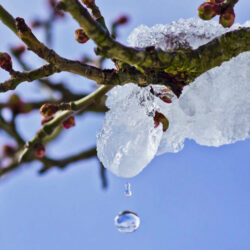
This month’s theme : Usui
Our theme for February’s menu is “Usui.” Usui is the season when snow turns into rain, and the snow and the ice on the ground turn into water. The severe cold starts to get milder and the snow starts to melt. It’s the start of a spring-like season when plants start to bloom. We picked Usui as the theme of February and expressed the changes in this season through our course meals, from appetizers to desserts. We hope you enjoy your meal feeling that the spring is just around the corner.
We also have a large selection of specially imported Italian wines to accompany our dishes and offer takeout and delivery menus. We believe you will find our restaurant to be an ideal location for dining with friends, family or colleagues.
We look forward to your visit.
------------------------------------------------------------------------------
This month's menu : Usui
Sakizuke:
Grilled mackerel in Yuan sauce and meringue, served with candied chestnut
Wan-mono:
Bonito-based soup and grated lotus root with oyster boiled oyster
Hassun:
Stewed beef tendon with teriyaki sauce and ginger
Jellied blowfish broth
Monkfish liver with sambal and lime
Boiled yellow Chinese leek, grated yam and kimizu
Boiled fresh gluten cake with miso and chocolate
Marinated leafy white veritable in lemon juice
Steamed egg custard with mushroom
Agemono:
Deep-fried tilefish, served with Steamed turnip and tilefish, served with salted Japanese butterbur
Kuchinaoshi:
Homemade ricotta cheese mixed with Hassaku orange
Main dish:
Kyoto style hot pot food;
chicken wing, radish with toro konbu, taro and konjac noodles
Shokuji:
Steamed rice with herring and Matsumae zuke -pickels
Dessert:
Hoji-tea ice cream
Castella with rape blossoms
Glaçage au Japanese raw wheat gluten
-

This month’s theme : White Snow
The theme for our January menu is "Shirayuki" or "White Snow." It's the season when snow-covered landscapes grace many places in Japan. Words like "shirayuki" (pure white snow), "sasameyuki" (fine snowflakes), "konayuki" (powdery snow), "awayuki" (snow drizzle), “watayuki” (cotton snow), and more, reflect the depth of Japanese sentiment in capturing the essence of snow. This time, we’ve selected "shirayuki" as the main theme for our January menu. From the appetizers to the desserts, the menu is crafted to conjure the image of pure white snow. While snow is typically associated with cold weather, this menu aims to impart a cozy atmosphere by highlighting the warmth of the dishes, aided by the presentation and tableware.
We also have a large selection of specially imported Italian wines to accompany our dishes and offer takeout and delivery menus. We believe you will find our restaurant to be an ideal location for dining with friends, family or colleagues.
We look forward to your visit.
------------------------------------------------------------------------------
This month's menu : White Snow
Sakizuke:
Snowflake made from lotus root, served with snow crab, mizuna and cucumber
Wan-mono:
Bonito-based soup and grated radish with steamed oyster dumpling
Hassun:
Yukina mixed with citrus sauce
Simmered lily bulb with milk
Igloo made from brussels sprouts
Boiled burdock mixed with cheese and sesame
Pickled celery with rice bran
Castella with cauliflower
Deep-fried Japanese smelt marinated in spicy vinegar sauce and thin radish
Mushimono:
Steamed turnip and tilefish, served with starched white wine sauce
Kuchinaoshi:
Snow made from soy pulp and lassie
Main dish:
Hot pot covered with light snowfall made from egg white
Shokuji:
Ochazuke with snow made from fresh cream and wasabi
Dessert:
Hoji-tea ice cream
Sweet bean ball, like a rabbit
Nougat with nuts and marshmallow
-

Shiwasu(the twelfth month of the lunar calendar)is fuyugomori
December is "Shiwasu(the twelfth month of the lunar calendar)is fuyugomori".
The term "fuyugomori" originally refers to the hibernation of brown bears. It is a behavior where they gather nutrients during the cold winter and store energy for spring activities. That's why in December, we prepared a menu with more warm and nutritious dishes than usual, hoping that you will get enough nutrients during this cold winter. We have also put effort into the presentation, so please enjoy the visually appealing dishes.
We also have a large selection of specially imported Italian wines to accompany our dishes and offer takeout and delivery menus. We believe you will find our restaurant to be an ideal location for dining with friends, family or colleagues.
We look forward to your visit.
------------------------------------------------------------------------------
Shiwasu(the twelfth month of the lunar calendar)is fuyugomori
Sakizuke:
Steamed egg custard with clam chowder, flavored with Japanese pepper
Wan-mono:
Hotpot bonito-based soup and formed chicken broth with shrimp dumpling
Hassun:
Mineoka tofu with soy milk, served with mandarin orange sauce
Steamed pumpkin with sage
Spicy brussels sprout
Mixed strawberry and pistachio with tofu and miso
Castella with burdock
Pickled yam in rice bran
Marinated mackerel in vegetable juice
Nimono:
Deep-fried tofu mixed with ginkgo and cheese, served with starched crab sauce
Kuchinaoshi:
Wafer cake with ricotta cheese and yuzu citron
Main dish:
Braised cha-mi-ton pork, like KOTATSU
Shokuji:
Thin wheat hot noodles with walnut milk soup
Dessert:
Hoji-tea ice cream
Sweet bean ball, like a calico cat
Sweet potato
-

Japanese harvest ritual
The theme for November’s menu is “Shimotsuki is Niiname-sai (The Month of Frost is a time for the Japanese harvest ritual).”
The character “name” in “Niiname-sai”—a festival during which thanks are given for that year’s harvest, and prayers are offered for a fruitful new year—means to “taste the flavor.” Since ancient times, rice and wheat have been highly treasured crops in Japan. Here at Yamashiroya, we also express our gratitude for the rice and wheat harvests in November, and we prepare these ingredients with great care and respect, and provide them to our guests in our own, unique way.
We hope you will enjoy the “taste” at “Yamashiroya’s Niiname-sai.”
We also have a large selection of specially imported Italian wines to accompany our dishes and offer takeout and delivery menus. We believe you will find our restaurant to be an ideal location for dining with friends, family or colleagues.
We look forward to your visit.
------------------------------------------------------------------------------
Japanese harvest ritual
Sakizuke:
Rice porridge with red beans and scarlet runner been, flavored with cinnamon
Wan-mono:
Bonito-based soup and grated yuba with shrimp dumpling and pepper
Hassun:
Deep-fried ear of rice
Squid sashimi with garlic olive oil
Mackerel brown rice toast sandwich with blue cheese
Pickled cauliflower in rice bran
Pickled green onions in sweet vinegar
Walnut tofu with walnut miso
Sweet potato chips with soybean flour
Agemono:
Deep-fried sea bream with rice cracker powder, served with rice gruel and vinegar
Kuchinaoshi:
Homemade ricotta cheese with pickled plum
Main dish:
Deep-fried glutinous wheat hamburger steak sandwiched between lotus root,
served with red wine and miso sauce
Shokuji:
Rice cooked with chestnuts and fresh cream
Red miso soup with porcini mushroom
Dessert:
Hoji-tea ice cream
Apple compote with sweet sake
Sweet bean ball with carrot
-

Kannaduki (the tenth month of the lunar calendar) is aging
October’s theme is “Kannaduki (the tenth month of the lunar calendar) is aging.”
Through aging, the flavors round out and the food develop different colors and aromas, and even the texture transforms. The wines regularly served at Yamashiroya also become more flavorful when aged for a certain period after fermentation. Speaking of aging, aged meats enjoyed widespread popularity some time ago. Being a Japanese restaurant, instead of meat, we age fish and vegetables and serve them to customers when they taste the best. As we advance further into the fall season, we invite you to savor the delightful combination of Kyoto Kuzushi Kappo (Kyoto-style Fusion) cuisine and aged food.
We also have a large selection of specially imported Italian wines to accompany our dishes and offer takeout and delivery menus. We believe you will find our restaurant to be an ideal location for dining with friends, family or colleagues.
We look forward to your visit.
------------------------------------------------------------------------------
Kannaduki (the tenth month of the lunar calendar) is aging
Sakizuke:
Sashimi tasting“preserved sea bream and dry-aged sea bream”
Wan-mono:
Bonito and garbanzo-based soup with venison dumpling
Hassun:
Salt-fermented squid viscera
Pickled conte in saikyo-miso
Homemade specs and fig
fruit lantern
Deep-fried gingko nut
Cooked and roasted chestnut
Pickled persimmon in bran
Nimono:
Dry-aged and backed onion, served with deep-fried ear of rice
Kuchinaoshi:
White wine sorbet with fifth category of taste
Main dish:
Pork cutlet, topped with egg yolk and grated yam
Shokuji:
Steamed rice with Hamo fish and matsutake mushroom
Tome-wan:
Red miso soup with marinated tofu in soy sauce malt
Dessert:
Hoji-tea ice cream
Sweet rice jelly with beet
Dry-aged grape jelly
-

Nagatsuki (the nineth month of the lunar calendar) is Chemistry
September’s theme is “Nagatsuki (the nineth month of the lunar calendar) is Chemistry.” Chemistry is a subject that studies how substances transform into something else. Cooking is closely related to chemistry in the sense that chemistry is used to change food ingredients to become delicious when cooking. For example, mayonnaise that everyone is familiar with is made using the emulsification of oil and vinegar not separating due to the functions of the lecithins in the egg yolk. Another example is how meat becomes more flavorful when grilled at high heat. This is due to the Maillard reaction caused by glucose and amino acids. As these examples show, cooking is an application of science. As you enjoy the changes in the season from summer to fall, also enjoy the collaboration of Kyo Kuzushi Kappo X Chemistry.
We also have a large selection of specially imported Italian wines to accompany our dishes and offer takeout and delivery menus. We believe you will find our restaurant to be an ideal location for dining with friends, family or colleagues.
We look forward to your visit.
------------------------------------------------------------------------------
Nagatsuki (the nineth month of the lunar calendar) is Chemistry
Sakizuke:
Boiled crown daisy, chrysanthemum and boiled Hamo fish, served with formed miso and vinegar
Wan-mono:
Bonito-based soup and grated purple cabbage with lamb dumpling
Hassun:
Cooked pacific saury with gochujang
Eggs boiled at 68 degrees for 30 minutes
Pickled persimmon in rice bran
Candied chestnut
Backed yam
Boiled and seasoned eggplant served with grated daikon
Deep-fried ginkgo nut
Otsukuri:
Low-temperature cooked bonito, topped with pak choi sprouts
Kuchinaoshi:
Sorbet with artificial flavored eggs
Main dish:
Braised pork and figs, topped with grilled sweet miso
Shokuji:
Sea bream otyazuke with walnut sauce and chinese red chili oil
Dessert:
Hoji-tea ice cream
Sweet bean ball with sweet potato
Simmered pear flavored with mustard
-

Hazuki (the eighth month of the lunar calendar) is the Hamo Fish Course
Our August theme is " Hazuki (the eighth month of the lunar calendar) is the Hamo Fish Course." A summer in Kyoto would not be complete without "hamo" (conger eel). In the old days, obtaining fresh fish in the central part of Kyoto, located inland, was quite challenging. Only the hardy hamo could survive the poor transportation conditions and be delivered live to Kyoto. However, the hamo has many small bones and cannot be eaten as it is. Therefore, ancient chefs invented a cooking method called "honekiri," where they make 26 cuts per inch, making it possible to eat the bony hamo. Hamo prepared using this traditional cooking method is simply exquisite.
At Yamashiroya Shozo, a Kyoto-style kaiseki restaurant, we have prepared a menu in August that allows you to enjoy hamo in various ways, including honekiri hamo, hamo eggs, bones, and the rich broth that can be extracted from them.
It is undeniably a “Hamo Feast." Come and enjoy the unique and creatively arranged hamo dishes that only Yamashiroya Shozo can offer.
We also have a large selection of specially imported Italian wines to accompany our dishes and offer takeout and delivery menus. We believe you will find our restaurant to be an ideal location for dining with friends, family or colleagues.
We look forward to your visit.
------------------------------------------------------------------------------
Hazuki (the eighth month of the lunar calendar) is the Hamo Fish Course
Sakizuke:
Boiled Hamo fish served with pickled plum jelly and water shield
Wan-mono:
Bonito-based soup and grated tomato with grilled Hamo and deep-fried Manganji pepper
Hassun:
Deep-fried Hamo bones
Salted Hamo roe with bell pepper and cucumber
Simmered sweet potato with honey and lemongrass
Pickled colinkey in rice bran
Spicy green soybeans
Green tomato pickled orange liqueur
Sashimi, squid and salmon roe
Agemono:
Hamo tempura served with curry salt and small ume
Kuchinaoshi:
Sake sorbet with unripe plum
Main dish:
Meatballs with truffles, topped with grated cucumber
Shokuji:
Steamed rice with grilled Hamo and corns with butter and soy souce
Red miso soup with selery
Dessert:
Hoji-tea ice cream
Candy apple
Custard pudding with Amazake
-
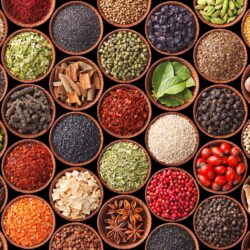
Fumizuki (the seventh month of the lunar calendar) is Spice
July’s theme is “Fumizuki (the seventh month of the lunar calendar) is spice.” In this hot season, we have prepared some spicy Japanese cuisine of Kyo Kuzushi Kappo. Spice is good in summer heat because it stimulates sweat and gastrointestinal functions. Because we have also added unique flavors and colors to it, please enjoy many different dishes you will not be able to taste anywhere else. The stew is made with mizansho (green Japanese peppercorns), one of Japan’s main spices. Please enjoy the spicy mizansho’s unique flavor. For the appetizer, we simmer Cha-mi-ton pork from Kagoshima Prefecture in a sweet and aromatic star anise sauce. Sweet potato is nectar stewed with lemongrass. It is a refreshing summer dish with a lemon aroma. Please enjoy our menu which uses spices from all over the world.
We also have a large selection of specially imported Italian wines to accompany our dishes and offer takeout and delivery menus. We believe you will find our restaurant to be an ideal location for dining with friends, family or colleagues.
We look forward to your visit.
------------------------------------------------------------------------------
Fumizuki (the seventh month of the lunar calendar) is Spice
Sakizuke:
Stewed conger eels in soy sauce and Japanese peppers, served with avocado and cream cheese, topped with fresh Japanese pepper
Wan-mono:
Bonito-based soup and green chili pepper soup with boiled conger pike
Hassun:
Stewed Cha-mi-ton pork from Kagoshima prefecture with soy sauce and star anise
Spicy green soybeans
Pickled ginger in vinegar and cloves
Chopped horse mackerel with miso and perilla
Deep-fried sardine sesame and cashew nuts
Pickled colinkey in rice bran
Nimono:
Simmered sea bass and Kyoto eggplant in bonito-based soup and curry spice
Kuchinaoshi:
Sake sorbet with unripe plum
Main dish:
Rolled chicken tempura with zuranfen paste (cumin powder)
Shokuji:
Steamed rice mixed with mussel and saffron, topped with salmon roe
Tome-wan:
Red miso soup with mozzarella cheese and scorched Japanese peppers
Dessert:
Hoji-tea ice cream
Sweet bean ball with wasabi
Pickled pineapple in syrup and Chinese five spices
-

Minazuki (the sixth month of the lunar calendar) is Smoked Food
The theme for June, “Minazuki (the sixth month of the lunar calendar) is Smoked Food." Smoked food is a preserved food made by smoking salted ingredients with woodfire to give them a unique smoky aroma. Some typical examples include salmon, bacon, and cheese. Common Japanese smoked food include katsuobushi (bonito flakes) and Akita's smoked pickled daikon radish, among others.
This month, we have incorporated smoked ingredients into our dishes and crafted a Kyoto-style kaiseki menu with smoked food. The starter, known as Hatsugatsuo no Tataki, is traditionally smoked with straw fire, but we used hojicha (roasted tea) to smoke it, enhancing the subtle aroma and umami flavor of the katsuo (bonito).
The soup dishes feature scallops, which are in season, cooked in the Shinjo-style. We hope you enjoy the soup broth extracted solely from bonito flakes, a rare case for Yamashiroya which is well-known for uncommon soup broths. You will surely appreciate bonito flakes’ reputation as Japan’s classic smoked food ingredient after tasting this dish. We look forward to serving you meals that include many smoked dishes in various dishes.
We also have a large selection of specially imported Italian wines to accompany our dishes and offer takeout and delivery menus. We believe you will find our restaurant to be an ideal location for dining with friends, family or colleagues.
We look forward to your visit.
------------------------------------------------------------------------------
Minazuki (the sixth month of the lunar calendar) is Smoked Food
Sakizuke:
Smoked “Katsuo no tataki” with roasted green tea
Wan-mono:
Bonito based soup with smoked dumpling scallop
Hassun:
Smoked daikon pickles and cheese fritters
Homemade 2kinds of dry-cured ham
Smoked boiled egg
Pickled white cucumber with olive oil
Deep-fried young ayu fish with herb
Nigiri sushi with pickled Japanese ginger in vinegar and clove
Mushimono:
Steamed garden eel and sliced burdock
Kuchinaoshi:
Sake sorbet with unripe plum
Main dish:
Roasted manganji pepper with minced pork, served with egg yolk
Shokuji:
Ochazuke with flavored bacon with rum and pickled plum
Dessert:
Hoji-tea ice cream
Sweet rice jelly with powdered green tea
Loquat compote with amaretto
-
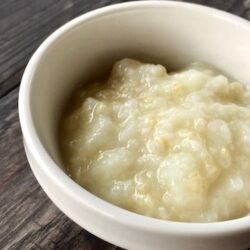
Satsuki (fifth month of the lunar calendar) is fermentation
The theme for May is "Satsuki (fifth month of the lunar calendar) is fermentation." Fermentation is the process of using microorganisms to enhance the flavor of food such as umami and sweetness, making it more delicious. Fermented foods contain plenty of antioxidants and good bacteria that improve gut health, benefiting not just your health but also beauty. Therefore, in May, we are serving Kyoto-style cuisine that features fermented foods from around the world. We also have homemade fermented foods available, such as nukazuke for appetizers and Amami-Oshima's fermented rice and sweet potatoes, called miki. For the amuse-bouche, pork and beef ham as well as preserved sardines will be served in a traditional hassun tray. Our steamed dish is a combination of fermented tomatoes and saury fish. We hope you enjoy the taste of homemade fermentation.
We also have a large selection of specially imported Italian wines to accompany our dishes and offer takeout and delivery menus. We believe you will find our restaurant to be an ideal location for dining with friends, family or colleagues.
We look forward to your visit.
------------------------------------------------------------------------------
Satsuki (the fifth month of the lunar calendar) is fermentation
Sakizuke:
Assorted pickled vegetables in rice bran, served with sweet sake and olive oil
Wan-mono:
Bonito based soup and fermented sweet potato soup, with deep-fried fat greenling
Hassun:
Boiled Kyoto green leaves mixed with blue cheese and sesames
Picked sardine in rice bran
Homemade hum; spec and bresaola
Cooked burdock root in spicy soy sauce and sugar
Lightly roasted bonito sashimi
Boiled green peas with sugar
Mushimono:
Steamed Japanese Spanish mackerel with salted rice malt and fermented tomato
Kuchinaoshi:
Sweety vinegar sorbet with sweety and sourly gingerroot
Main dish:
Pork cutlet topped with butterbur shoot miso
Shokuji:
Deep-fried kimchi tempura bawl
Red miso soup with freshwater clam and fermented butter
Dessert:
Hoji-tea ice cream
Sweet bean ball with mugwort
Baked yogurt
-
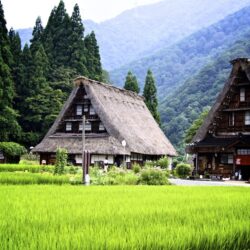
Uzuki (fourth month of the lunar calendar) is local cuisine
The theme of our menu for April is regional cuisine. Regional cuisine refers to dishes that have been handed down from one generation to the next in a particular region, prepared in a manner unique to that region using ingredients that have taken root in the region over time. However, food distribution, processing, and storage technology have become so modernized today that the regional qualities of food have started to wane.
In view of this, our menu for this month features a completely new combination of regional cuisines from all over Japan never attempted before, ranging from Hokkaido in the north to Okinawa in the south, presented in the style of “Kyo-kuzushi kappo.”
We hope you will get to experience the wonderful culinary culture of Japan that is gradually being forgotten.
We also have a large selection of specially imported Italian wines to accompany our dishes and offer takeout and delivery menus. We believe you will find our restaurant to be an ideal location for dining with friends, family or colleagues.
We look forward to your visit.
------------------------------------------------------------------------------
Uzuki (fourth month of the lunar calendar) is local cuisine
Kyoto prefecture’s Sakizuke:
Dried young sardines and Japanese pepper served with avocado and cream cheese
Akita prefecture’s Wan-mono:
Natto and Bonito based soup with tofu and minced pork dumpling
Various local’s Hassun:
Sakura shrimp fritter and cherry blossoms scented salt
Spicy tofu
Sardine dumpling served with hand-rolled nori
Boiled edible wild plants“KOGOMI”with yuzu pepper
Sweet cooked carrot
Marinated spring sea bream sashimi in Kyoto miso
Hokkaido’s Nimono:
Cooked salmon trout, petit verre, peccoros with cream and miso sauce
Kuchinaoshi:
Cherry blossom sorbet
Miyazaki’s Main dish:
Fried chicken with vinegar, sambal and tartar sauce
Tokyo’s Shokuji:
Fukagawa-meshi ochazuke with leaf bud
Various local’s Dessert:
Hoji-tea ice cream
Milk and sweet bean jelly with strawberry
Bean ball with cherry blossoms
-

Spring Bread Festival
"Spring Bread Festival" is the theme of the menu for March. In honor of the "Spring Bread Festival" held every year by a certain bakery, which is well known for giving away white plates as gifts, Yamashiroya Shozo has prepared a bread-filled menu.
The first course will be an egg sandwich, popular at coffee shops in Kyoto, called the “Kyoto egg sandwich". Enjoy this unusual sandwich made, with Japanese ingredients sandwiched between two pieces of bread.
In the bowls are homemade croutons, which look and taste amazing. We have also prepared other dishes that will surprise you, such as dishes which use different kinds of bread and Japanese ingredients as bread.
We also have a large selection of specially imported Italian wines to accompany our dishes and offer takeout and delivery menus. We believe you will find our restaurant to be an ideal location for dining with friends, family or colleagues.
We look forward to your visit.
------------------------------------------------------------------------------
Spring Bread Festival
Sakizuke:
Egg sandwich alla Kyoto
Wan-mono:
Chicken broth with large crouton
Hassun:
Butterbur sprout miso with grissini
Boiled bamboo shoot mixed with bread crumbs and black garlic paste
Firefly squid mixed with peanut butter and miso
Pickled red snapper sashimi in saikyo miso
Pickled seasonal onion in red plum vinegar, topped with snow crab
Castella with rape blossoms
Pickled broccoli in rice bran with white sesame
Agemono:
Templa; flour tortillas rolled around cherry salmon and asparagus
Kuchinaoshi:
Homemade ricotta cheese mixed with mint and matcha
Main dish:
Grilled chicken with nut butter and sesame
Shokuji:
Seafood chirashi sushi
Red miso soup with deep-fried Japanese wild edible plants
Dessert:
Hoji-tea ice cream
White bread with cream cheese
Half dried kiwi
-

Festivals of Early Flower Month
The theme of the February menu is “Festivals of Early Flower Month.” Early Flower Month, also known as February, is named after the first flowers that bloom in the year, which are plums. Although many people think of cherry blossoms when they hear the word “flower”, the first flowers of the year are actually plums. This is why the traditional Japanese calendar calls February the Early Flower Month.
Changing the subject, February is a month with many famous events. Here at Yamashiroya Shozan, we have created menus based on the themes of the events such as “First Horse Day”, “Setsubun” and “Valentine's Day”. This year, we will prepare a menu that incorporates all these festivals, and also makes use of the plums which is the first flower of the year. We believe that by enjoying the course to the end, you will be able to fully experience February.
We also have a large selection of specially imported Italian wines to accompany our dishes and offer takeout and delivery menus. We believe you will find our restaurant to be an ideal location for dining with friends, family or colleagues.
We look forward to your visit.
------------------------------------------------------------------------------
Festivals of Early Flower Month
Sakizuke:
Thyme flavored sushi wrapped with deep-fried tofu
Wan-mono:
Bonita, black ginger milk Kuzu starch soup with cod milt
Hassun:
Roasted soy beans
Cooked lotus root with spicy cod roe
Plum-flavored gluten
Deep-fried sardine with nutmeg
Millet wheat gluten covered with chocolate
Pickled califlore in rice bran
Scorched yellowtail with plum liqueur jelly
Nimono:
Kyoto radish and deep-fried sea bream cooked in bonito-based soup with curry flavor
Kuchinaoshi:
Homemade ricotta cheese with plum
Main dish:
Pork tempura served with cheese fondue
Shokuji:
Plum ochazuke with hibiscus tea
Dessert:
Hoji-tea ice cream
Ganache with red wine
Sweet been ball with green peas
-

New Year’s Gift
The theme of our January menu is "New Year's gift." January is the month for celebrating the beginning of a new year.
With this in mind, we at Yamashiroya Shozo have prepared a New Year's gift for our guests to enjoy throughout the month.
For the appetizer, we welcome you with a platter of traditional Japanese New Year’s-style cuisine in honor of the New Year. This is followed by a Kyoto-style New Year mochi soup called ozoni. We hope you enjoy our unique way of eating mochi rice cakes dipped in roasted soybean flour.
For the fried dish and palate cleanser, we have prepared dishes that look like a decorative paper envelope for giving New Year's gifts and a wrapped offering of money. Although you don't often have a chance to receive a New Year's gift, we hope you will enjoy a special New Year's gift from us at Yamashiroya Shozo.
We also have a large selection of specially imported Italian wines to accompany our dishes and offer takeout and delivery menus. We believe you will find our restaurant to be an ideal location for dining with friends, family or colleagues.
We look forward to your visit.
------------------------------------------------------------------------------
New Year’s Gift
Sakizuke-Hassun:
Kelp with herring roe
Boiled black beans with dark rum
Boiled burdock root mixed with spicy cod roe and pomegranate
Fish cake pickled in rice bran
Cooked lotus flavored with cumin
Sweet rolled omelet hoji tea
Deep-fried smelt with sesame
Wan-mono:
Traditional New Year’s soup with miso and rice cake
Otsukuri:
Red & White sashimi with soy sauce and fermented black beans
Agemono:
For New Year’s Gift; Cream croquet with porcini mushrooms and scallops
Kuchinaoshi:
For New Year’s Gift; Citrus sudachi ball with homemade ricotta cheese
Main dish:
Lightly-roasted venison served with apple and onion soy sauce
Shokuji:
Steamed rice with mussels and saffron
Tomewan:
Red miso soup with mozzarella cheese
Dessert:
Hoji-tea ice cream
Sweet boiled burdock root with sweet red beans
Bean ball with lily bulb
-
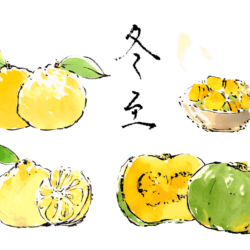
Winter Solstice
The theme of December’s menu is “winter solstice”. The winter solstice is the day with the longest night and the shortest daytime each year. Therefore, the sun’s strength is at its lowest ebb on this day. After this day, however, the sun’s strength begins to return, making the winter solstice an optimistic time. For this reason, it is said that our fortunes begin to rise after the winter solstice.
Ingredients relating to the winter solstice include pumpkin (seven hibernal flowers), adzuki, and yuzu.
For the appetizer, we ward against bad luck before calling for the good. We prepared adzuki as the appetizer because they are said to have the power to protect against misfortune.
Everyone likes to take a yuzu bath on the winter solstice. This comes from a play on words: taking the baths to cure sickness (touji) on the winter solstice (touji). Yuzu is therefore used to flavor the ricotta cheese palate cleanser.
Pumpkins are summer vegetables, but because they can be stored for a long time, they were a valuable source of nutrition during the winter months when food was scarce. Eating pumpkin is meant to give encouragement to help us make it through the harsh winter.
For December we have prepared a menu in the hopes of keeping you in good health and improving your fortunes. Please come and enjoy the food to help bring in the new year.
We also have a large selection of specially imported Italian wines to accompany our dishes and offer takeout and delivery menus. We believe you will find our restaurant to be an ideal location for dining with friends, family or colleagues.
We look forward to your visit.
------------------------------------------------------------------------------
Winter Solstice
Sakizuke:
Rice porridge with red beans and scarlet runner been
Wan-mono:
Bonito-based soup with grated Chinese cabbage, monkfish liver pate and garlic
Hassun:
Cooked kumquat in sugar
Cooked red konnyaku in bonito-based soup
Strawberry and pistachio mixed with tofu
Cooked daikon radish topped with sweet miso and beats
Tempra pickled mushroom in rice bran
Salmon roe and egg yolk
Deep-fried spam rolled in seaweed
Agemono:
Steamed yellowtail and Kyoto yam, covered with grated pear
Kuchinaoshi:
Crispy wafers with homemade ricotta cheese and Yuzu
Main dish:
Sweet and sour pork with pumpkin
Shokuji:
Ochazuke with soy milk, topped with tuna pickled in soy sauce and garlic
Dessert:
Hoji-tea ice cream
Deep-fried buck wheat cookies flavored with Japanese mustard
Sweet jelly with strawberry and condensed milk
-
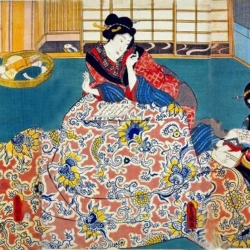
Kotatsu Opening
The theme for November’s menu is “Kotatsu Opening.” November will bring more cold days. It’s the time of year when we wonder when we should take out our heater. In the old days, people would open the kotatsu on the day of the Boar (old lunar calendar), so it is said that it’s a good time to bring out the heater. Thus, we welcome you to the November theme, “Kotatsu Opening,” with a menu that is just like a kotatsu, warming your body and soul on a cold day. Since “Kotatsu Opening” is done on the day of the Boar, we have prepared a dish of pickled melon and mackerel, named after the child of a boar, Uribo. The grilled mackerel and the sweetness of the pickled melon are a perfect match. The next bowl is mizore soup with Shogoin Kyoto turnips. This wintery dish is made with grated turnips to express the mizore. The soup is made with light kudzu sauce, so it does not get cold easily and you can enjoy the hot broth. It’s natural to eat tangerines when sitting under a kotatsu. For the appetizer, we served tangerines with shira-ae. Other dishes are also served with kudzu sauce, so please enjoy the warmth of our food.
We also have a large selection of specially imported Italian wines to accompany our dishes and offer takeout and delivery menus. We believe you will find our restaurant to be an ideal location for dining with friends, family or colleagues.
We look forward to your visit.
------------------------------------------------------------------------------
Kotatsu Opening
Sakizuke:
White melon pickled in sake lees and grilled mackerel
Wan-mono:
Grilled sea bream in bonito-based soup with grated Kyoto radish
Hassun:
Baked minced chicken and cartilage flavored with cumin seeds
Sweet and spicy quail egg
Daikon pickled in salted rice yeast
Castella with taro
Carrot boiled in oil
Tiny sushi ball with squid
Mandarin mixed with tofu and saikyo miso
Agemono:
Deep-fried Hamo fish with herb bread crumbs, served with starchy sauce and couscous
Kuchinaoshi:
Homemade ricotta cheese
Main dish:
Meat balls with truffe, served with grated cucumber
Shokuji:
Ochazuke carbonara with fresh pepper
Dessert:
Hoji-tea ice cream
Baked apple with brown sugar syrup
Bean ball with sweet potato
-

Autumn leaves
The theme for October’s menu is “autumn leaves”. In autumn, leaves turn beautiful colors, enveloping the town in beautiful scenery. Autumn leaves are as popular as cherry blossoms are in spring. This is why, for October, we chose to use red autumn leaves as a theme for our dishes. From appetizer to hassun dish, everything will follow this theme. “Momiji” is the name given to the leaves of maple trees when they change color, and are one of the most notable examples of autumn leaves, which has resulted in the Japanese word for autumn leaves to be read as “momiji”. Our dishes will be served in red dishes inspired by their color, and are sure to be a feast for the eyes.
We also have a large selection of specially imported Italian wines to accompany our dishes and offer takeout and delivery menus. We believe you will find our restaurant to be an ideal location for dining with friends, family or colleagues.
We look forward to your visit.
------------------------------------------------------------------------------
Autumn leaves
Sakizuke:
Broiled tilefish with carrot and mayonnaise, served with pickled Japanese ginger and spicy ginkgo nut
Wan-mono:
Bonito and garbanzo-based soup with venison dumpling
Hassun:
Sea bream cured with kombu
Cooked and roasted chestnut
Cooked Hamo roe with curry powder
Momiji fu flavored with Japanese pepper
Millefeuille with smoked salmon and cucumber
Turnip pickled in bran
Nimono:
Steamed glutinous rice topped with Hamo fish and matsutake mushroom
Kuchinaoshi:
Persimmon vinegar and Amazake sorbet
Main dish:
Deep-fried chicken with cinnamon
Shokuji:
Coffee ochazuke with sweet-and-salty pork
Dessert:
Hoji-tea ice cream
Castella with pumpkin
Sweet rice jelly with beet
-
-250x250.jpg)
Kiri-hito-ha
The theme for September’s menu is kiri-hito-ha, a kigo, or poetic seasonal phrase meaning, “a single Paulownia leaf.” Among the many trees that shed their leaves in the fall, the Paulownia is the very first to do so. It is when watching the Paulownia leaf fall that we learn that fall has arrived. This is the scene that kiri-hito-ha depicts. Yamashiro-ya Shozo’s menu for September will make you feel the beginnings of autumn. For our appetizer, we have used chrystanthemums in honor of the seasonal Chrysanthemum festival. The wan-mono (wooden bowl) dish that follows also evokes autumn with cosmos (also known as “autumn cherry blossoms”) scattered on the dish. Among our hassun (small dishes), we have prepared tsukimi-dango, or “moon-viewing mochi,” in the likeness of Japanese silver grass, reminiscent of the season of the harvest moon. We hope you enjoy these and many other dishes in the theme of kiri-hito-ha that are full with ingredients that will make you experience the coming of fall.
We also have a large selection of specially imported Italian wines to accompany our dishes and offer takeout and delivery menus. We believe you will find our restaurant to be an ideal location for dining with friends, family or colleagues.
We look forward to your visit.
------------------------------------------------------------------------------
Kiri-hito-ha
Sakizuke:
A dashi of boiled edible chrysanthemums and garland chrysanthemums in soy sauce, served with boiled Hamo fish
Wan-mono:
Thin soup made from boiling sea bream served with Cosmos petals
Hassun:
Deep-fried enoki mushrooms
Moon-viewing dumpling with Foie gras
Marinated turnip in vinegar and soy sauce
Baked Japanese yam with garlic and soy sauce
Eggplant and soy milk jelly
Pickled gingko in rice bran
Hamo roe cooked with curry powder
Mushimono:
Turned bonito and fig, served with sesame and miso cream sauce
Kuchinaoshi:
Green papaya sorbet
Main dish:
Pork cutlet with meringue and row egg
Shokuji:
Steamed rice with olive fruit
Red miso soup with pickled maitake mushroom in rice bran
Dessert:
Hoji-tea ice cream
Sweet bean ball with chestnut
Red wine jerry with grape
-
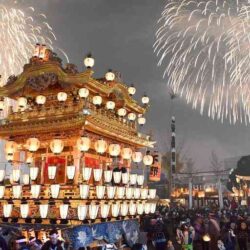
Summer Festival
The theme of our August menu is “Natsumatsuri” (Summer festival). Lively festivals are held in many places in summer, and we hope that you can enjoy the vibes of exciting summer festivals through the dishes we are serving this month.
For the appetizer, we will be serving ground cherries that resemble the lanterns used to mark the return of the spirits of ancestors during the Bon Festival. This is followed by a seasonal dish, a fried dish, and a palate cleanser reminiscent of the dishes served by food stands at a festival. The menu also features okonomiyaki, chocolate bananas, takoyaki, and shaved ice served in Yamashiroya’s unique style, allowing you to indulge in the atmosphere of a summer festival. Other summer ingredients that will surely make this a memorable dining experience are also showcased.
We also have a large selection of specially imported Italian wines to accompany our dishes and offer takeout and delivery menus. We believe you will find our restaurant to be an ideal location for dining with friends, family or colleagues.
We look forward to your visit.
------------------------------------------------------------------------------
Summer Festival
Sakizuke:
Chinese lanterns
Wan-mono:
Bonito-based and grated asparagus soup with tofu and bitter melon
Hassun:
Boiled peanuts
Teriyaki eel and cucumber
Pickled Japanese ginger in red wine and cloves
Pickled green tomato in amaretto
Grilled corn
Baked squid with Shuto
Japanese savory pancake with shrimp
Chocolate-coated banana with rice crackers
Agemono:
Octopus dumplings
Kuchinaoshi:
Shaved ice
Main dish:
Chicken roll stuffed with ratatouille, served with pickled shishito pepper in rice bran
Shokuji:
Steamed rice with grilled Hamo and tomato
Spicy red miso soup
Dessert:
Hoji-tea ice cream
Toffee apple
Pudding with amazake
-
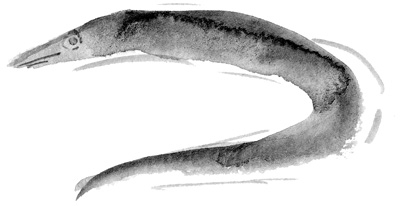
Hamo-centric Dishes
The theme of our menu for July is “Hamo-centric Dishes.” One of the three major festivals in Kyoto, the Gion Festival is also known as the Hamo (pike conger) Festival. July, the month when the Gion Festival is held, is also the time of the year when consumption of hamo is at its highest. It used to be very difficult to find fresh fish in central Kyoto in the past due to its inland location. Despite the poor transport links, hamo was the only fish that could be transported alive to Kyoto thanks to the fortitude of the fish. However, hamo has many tiny bones, making it impossible to consume directly. For this reason, cooks in ancient times devised a culinary technique called honekiri, where 26 fine cuts are made per inch of hamo to make the fish edible even with its tiny bones. Hamo prepared using this traditional culinary technique is exquisite. For July, Yamashiroya Shozo’s Kyo-kuzushi Kappo will be serving a menu that features not only hamo prepared using the honekiri method but also hamo roe, liver, bones, as well as dashi broth simmered with hamo, that you will surely enjoy.
Our “Hamo-centric Dishes” menu will allow you to experience hamo dishes that bring the unique ideas of Yamashiroya Shozo to life.
We also have a large selection of specially imported Italian wines to accompany our dishes and offer takeout and delivery menus. We believe you will find our restaurant to be an ideal location for dining with friends, family or colleagues.
We look forward to your visit.
------------------------------------------------------------------------------
Hamo-centric Dishes
Sakizuke:
Hamo fish roe cooked with green Japanese pepper
Wan-mono:
Bonito-based soup with boiled Hamo and water shield
Hassun:
Seared Hamo and wasabi
Deep-fried Hamo bones and red perilla salt
Moroheiya and shrimp
Pickled melon cucumber with tapenade
Zucchini pickled in rice bran
Castella with fig and saikyo-miso
Agemono:
Hamo tempura served with curry salt and small ume
Kuchinaoshi:
Bitter gourd sorbet
Main dish:
Roasted duck served with gourd and grapefruit
Shokuji:
Japanese mixed rice with Hamo and green chili
Hamo liver soup
Dessert:
Hoji-tea ice cream
Green tomato pickled peach liqueur
Bean ball with Japanese mugwort
-

Samidare
The menu theme for June is "Samidare." Samidare refers to the rain during the fifth month of the lunar calendar, which corresponds to June in the modern calendar. In other words, it is a reference to the rainy season. The term was used as an alternate name for the fifth month under the lunar calendar system.
What comes to your mind when you think about the rainy season? Many people probably associate it with snails and hydrangeas. That is why we serve escargot with fresh seasonal potatoes for the tsukidashi (appetizer). The wanmono (soup) is hydrangea soup. Since actual hydrangea plants are poisonous, we prepared soup resembling the appearance of hydrangeas for your visual enjoyment. We have also prepared other dishes connected with the rainy season, such as plums and shigureni, which we hope you will enjoy.
We also have a large selection of specially imported Italian wines to accompany our dishes and offer takeout and delivery menus. We believe you will find our restaurant to be an ideal location for dining with friends, family or colleagues.
We look forward to your visit.
------------------------------------------------------------------------------
Samidare
Sakizuke:
Japanese modern style escargot
Wan-mono:
Soup with hydrangea
Hassun:
Ginger-simmered beef in sweetened soy sauce
Minced mackerel with sake and plum jelly
Seared bonito
Boiled New Zealand spinach mixed with blue cheese
Pickled snap pea in rice bran
Muscat mixed with tofu and miso
Marinated lotus in vinegar with thyme
Nimono:
Simmered octopus with plum, avocado form, served cold
Kuchinaoshi:
Green plum sorbet
Main dish:
Pork shabu-shabu like a kishimen
Shokuji:
Deep-fried Korean style pancake rice bowl
Red miso soup with freshwater calms
Dessert:
Hoji-tea ice cream
Sweet bean jelly with apricot
Guimauve with bitter summer orange
-
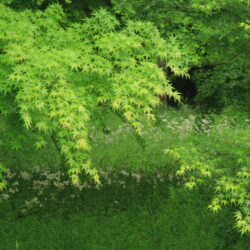
Kazekaoru
Kazekaoru is the theme of our menu for May, a reference to the cool light breezes of early summer that rustle through the green leaves of lush trees in this season.
The appetizer is made with Takigawa tofu and deep-fried small ayu fish infused with hints of sage to create a refreshing dish that represents early summer. For the wanmono (course served in a small bowl), subtle traces of mint imbue the grated fava bean soup with fresh and invigorating flavors. Our offerings also include tempura made from such delicacies as new tea shoots and ice plants, as well as other lush dishes such as basil-flavored tartar. Please come enjoy our delicious and aromatic menu, just as fragrant and refreshing as an early summer’s breeze.
We also have a large selection of specially imported Italian wines to accompany our dishes and offer takeout and delivery menus. We believe you will find our restaurant to be an ideal location for dining with friends, family or colleagues.
We look forward to your visit.
------------------------------------------------------------------------------
Kazekaoru
Sakizuke:
Takigawatofu served with deep-fried young ayu
Wan-mono:
Bonito and broad beans soup with deep-fried fat greenling and pepper mint leaf
Hassun:
Rhubarb pickled in rice bran
Tempura sprout of fresh tea and tempura ice plants
Cooked butterbur covered with chocolate
Vinegared mozuku seaweed
Oak leaf rice cake with braised pork
Sashimi, squid and salmon roe
Nimono:
Low-temperature steamed the season’s first bonito served with grilled vegetables
Kuchinaoshi:
Japanese pepper-bud sorbet
Main dish:
Deep-fried free rang chicken served with basil mayonnaise
Shokuji:
Ochazuke with sardine pickled in rice bran, and seaweed
Red miso soup mussel
Dessert:
Hoji-tea ice cream
Cherry jelly
Nerikiri with honey
-

Hana Matsuri
The theme of our menu for April is “Hana Matsuri” (Flower Festival). Hana Matsuri is a Buddhist event that commemorates the birth of the Buddha.
During Hana Matsuri, hydrangea tea is served to visitors at many temples. Adhering to the customs of this event, Yamashiroya Shozo will be serving hydrangea tea at the start of the meal. We have prepared a course menu that showcases ingredients reminiscent of spring, including broad beans, mountain asparagus, bamboo shoots, etc., all of which often featured at Hana Matsuri.
We have also prepared a wide selection of Italian wines imported by our company to complement the menu, and we are confident that you will be able to enjoy an unforgettable meal with your family and friends, business associates, or other guests. We look forward to serving you at our restaurant.
------------------------------------------------------------------------------
Hana Matsuri
Sakizuke:
Bracken starch tofu cake topped with broad beans and fermented cream sauce
Wan-mono:
Bonito-based soup with foie gras, turnip and wheat gluten
Hassun:
Pickled lotus root in sweet vinegar and Hassaku orange
Wheat gluten with Japanese mugwort and miso
Sauteed Udo with red wine
Japanese icefish mixed with salted rice malt
Savoy cabbage with garlic miso
Marinated sea bream in Komb
Spring onions tempura
Nimono:
Cooked ocellated octopus with risoni and rape blossoms
Kuchinaoshi:
Cherry blossoms sorbet
Main dish:
Pork cutlet topped with Japanese pepper miso, served with pickled bamboo shoot in bran
Shokuji:
Chinese pepper steamed rice topped with Spanish mackerel and Japanese pepper
Red miso soup mussel
Dessert:
Hoji-tea ice cream
Skewered “amacha”dumplings with sweet green soybeans paste
Marshmallow with strawberry
-
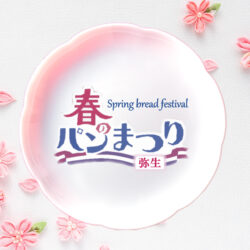
Spring Bread Festival
The theme of our March menu is “Spring Bread Festival.” Drawing inspiration from the “Spring Bread Festival” held by a certain popular bakery every year where they give away white plates, Yamashiroya has also prepared a menu starring bread.
The first dish on this menu is “Kyo Tamago Sandwich,” an egg sandwich commonly found in Kyoto’s cafés. Please enjoy this unusual sandwich that is made by serving Japanese ingredients between slices of bread. The soup bowl on this menu features our homemade croutons, which have a striking flavor and appearance. Also comprising other dishes that we have prepared using different kinds of bread and Japanese ingredients in the style of bread that you are sure to enjoy, this menu is full of surprises. We hope you will like our March menu.
We also have a large selection of specially imported Italian wines to accompany our dishes and offer takeout and delivery menus. We believe you will find our restaurant to be an ideal location for dining with friends, family or colleagues.
We look forward to your visit.
------------------------------------------------------------------------------
Spring Bread Festival
Sakizuke:
Egg sandwich alla Kyoto
Wan-mono:
Crouton flavored with saffron
Grated cauliflower and bonito-based soup, with grilled spanish mackerel and rape blossoms
Hassun:
Butterbur sprout miso with grissini
Spicy firefly squid
Pickled celery in rice bran
Roquette and mustard greens mixed with mustard and vinegar
Castella with hijiki seaweed
Toasted wheat gluten topped with Japanese tapenade
Yam and crown daisy marinated on kelp seaweed
Agemono:
Templa; flour tortillas rolled around cherry salmon and asparagus
Kuchinaoshi:
Ricotta cheese mixed with saikyo miso and Japanese pepper
Main dish:
Steamed chicken in fermented fish soy sauce, served with udo, Japanese parsley and preserved tofu
Shokuji:
Steamed green peas rice topped with toast crumbs
Red miso soup with Japanese ginger
Dessert:
Hoji-tea ice cream
Steamed cake with sweetened beans
Bean ball with wormwood
-

Valentine’s Day
The theme of February's menu is "Valentine's Day". In Japan, the custom is for women to give chocolates to men on February 14th. We have accordingly prepared a February menu that uses chocolate and roses as ingredients.
For the appetizer, we have a dengaku of awabu and gomafu made with chocolate. As is typical of Kyo-kuzushi kappo, guests can personally spread the miso onto the dengaku before enjoying. The next dish is a dashi made using rose hips. Please use all five senses to enjoy the rose fragrance and the beautiful pink-colored dashi. Both the classic palate cleanser of homemade ricotta cheese as well as the ochazuke entrée are made with cacao, the precursor of chocolate. Please savor the taste of cacao.
We have prepared a unique menu for your dining pleasure, and we hope you will enjoy it.
We also have a large selection of specially imported Italian wines to accompany our dishes and offer takeout and delivery menus. We believe you will find our restaurant to be an ideal location for dining with friends, family or colleagues.
------------------------------------------------------------------------------
Valentine's Day
Sakizuke
Millet wheat gluten and sesame wheat gluten with sweet miso and chocolate paste
Wan-mono:
Rose hips and bonito-based soup with crab dumpling and rose petal
Hassun:
Blowfish skin pink jelly
Pickled Fourme d’Ambert in rice bran
Lily bulb soup
Pickled lotus root with rice seasoning
Castella with ripe blossoms
Smoked salmon, pickled sliced radishes and cucumber, millefeuille style, served with salmon roe
Nimono:
Cooked radish topped with yellowtail and foie gras
Kuchinaoshi
Ricotta cheese with cacao, served with Japanese pepper
Main dish:
Deep-fried gyutan with rosemary, served with pickled onion and raisins
Shokuji:
Cacao nibs ochazuke with magret de canard and Kyoto green onion
Dessert:
Hoji-tea ice cream
Ganache with sake
Red bean jelly with coffee
-
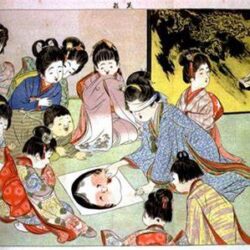
Happy New Year
The theme for our menu in January is “Happy New Year”.
For January, we have prepared an auspicious menu to celebrate the beginning of the new year.
The appetizers are arranged like Osechi (Japanese New Year dishes) to get you into the New Year mood.
Next, for soups, we have the classic New Year dish, Ozoni (Japanese New Year Mochi Soup). As our restaurant serves Japanese Kyo-kuzushi kappo (Kyoto Deconstructed Fine Dining) cuisines, we used a white miso base, in the Kyoto style. For the sashimi and palate cleanser, please enjoy the auspicious red and white arrangement.
Come and celebrate the beginning of the new year at Yamashiro-ya Shozo.
We also have a large selection of specially imported Italian wines to accompany our dishes and offer takeout and delivery menus. We believe you will find our restaurant to be an ideal location for dining with friends, family or colleagues.
We look forward to your visit.
------------------------------------------------------------------------------
Happy New Year
Sakizuke-Hassun:
Deep-fried kuwai with trifle salt
Chishatou
Burdock root mixed with spicy pollack roe and cheese
Simmered black soy-beans with sweet brandy
Teriyaki dried sardines
Grilled yellowtail with miso and olive
Pickled lotus root with thyme
Wan-mono:
Traditional New Year’s soup with miso and rice cake
Otsukuri:
Red & White sashimi with soy sauce and red wine
Mushi-mono:
Steamed Kyoto radish and tilefish
Kuchinaoshi
Ricotta cheese in red & white
Main dish:
Steamed venison with red miso, served with pickled petit daikon in rice bran
Shokuji:
Steamed oyster rice with saffron
Clear soup with raisins
Dessert:
Hoji-tea ice cream
Bean ball with sake lees
Sweet bean jelly with tiger pattern
-

Christmas
The theme for December’s menu is “Christmas”. We have reimagined Christmas cuisine in a Japanese Kyo-kuzushi kappo style.
Our appetizer this month is a small tofu pouch that looks just like Santa’s sack. Eat it to find out what delicious present is inside.
Our bowl is a beef stew with bonito broth, prepared with miso. We hope you will enjoy this Japanese-style beef stew.
For our main dish we have prepared tempura wings. This Christmas, why not forget the turkey or fried chicken, and enjoy chicken wings tempura at Yamashiroyashozo?
We also have a large selection of specially imported Italian wines to accompany our dishes and offer takeout and delivery menus. We believe you will find our restaurant to be an ideal location for dining with friends, family or colleagues.
We look forward to your visit.
------------------------------------------------------------------------------
Christmas
Sakizuke:
Santa’s small sack with tomato and miso sauce
Wan-mono:
Beef stew with bonito-based miso soup
Hassun:
Mashed sweet chinese yam and red peas
Strawberry tempura
Carrot castella
Pickled red and white chinese artichoke in sweet and sour sauce
Chawan-mushi with spinach
Pickled cauliflower in rice bran
Broiled shogoin daikon with monkfish liver and cream sauce
Yaki-mono:
Steamed yellowtail and ebi-imo taro, topped with grated pear
Kuchinaoshi
Ricotta cheese flavored with cumin seeds
Main dish:
Chicken drumstick tempura with dipping sauce for tempura
Shokuji:
Sushi such as the camellia, salmon, radish, and squid
Red miso soup with red wine and raisins
Dessert:
Hoji-tea ice cream
Sweet potato with ginger
Gateau chocolate with chest nut
-
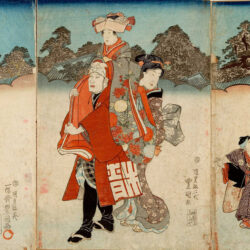
Shichi-Go-San
The theme for November’s menu is “Shichi-Go-San.” Shichi-Go-San is an event that celebrates the growth of children since the Heian period. I prepared this menu to pray for the healthy growth and happiness of the children that will support Japan in the future.
The appetizer is Yamashiroya Shozo's signature red rice. All our employees tie “mizuhiki” ornaments with their wishes. For the appetizer, we prepared a lovely homemade Chitose-ame candy. The menu also includes sea bream and red and white ingredients for a celebratory occasion.
We also have a large selection of specially imported Italian wines to accompany our dishes and offer takeout and delivery menus. We believe you will find our restaurant to be an ideal location for dining with friends, family or colleagues.
We look forward to your visit.
------------------------------------------------------------------------------
Shichi-Go-San
Sakizuke:
Red rice with“mizuhiki”ornament
Wan-mono:
Grated garbanzo beans in bonito-base soup with kebab
Hassun:
Monkfish liver with ponzu
Three-color pickles flavored with lemon grass
Spam cutlet
Pickled mushroom in bran tempura
Homemade chitose candy
Pickled mackerel with cumin
Sweet potato cheese cake with apricot
Mushi-mono:
Low-temperature cooked autumn sea bream, served with genovese sauce
Kuchinaoshi
Homemade ricotta cheese
Main dish:
Magrets duck cooked in red wine with juniper berry, served with foie gras and baked apple
Shokuji:
Conger chirashi sushi with pickled green shiso leaves and myoga radish
Red miso soup with cream cheese
Dessert:
Hoji-tea ice cream
Baked persimmon
Lotus roots pudding
-

Halloween
The theme of our menu for October is “Halloween,” and it will feature pumpkin and sweets that will remind you of Halloween.
Celebrated on October 31st every year, Halloween has been rapidly gaining popularity in recent years. Shibuya, where our restaurant is located, will get in the mood for Halloween once October comes around, and you can enjoy the sight of people dressed in costumes. We hope you look forward to our original Halloween-themed Kyo-kuzushi kappo that will be served at Yamashiroya Shozo this autumn in Shibuya, the city of Halloween.
We also have a large selection of specially imported Italian wines to accompany our dishes and offer takeout and delivery menus. We believe you will find our restaurant to be an ideal location for dining with friends, family or colleagues.
We look forward to your visit.
------------------------------------------------------------------------------
Halloween
Sakizuke:
Ball-shaped tuna sushi, like a candy
Wan-mono:
Grated broad peanut-pumpkin soup with biscuit and foie gras
Hassun:
Ginkgo nut, radish and purple sweet potato, served with bagna càuda and miso
Deep-fried shiitake mushroom with rice crackers
Pickled colinky in rice bran
Stir-fried yam with truffle salt
Steamed taro with miso and chocolate
Sweet rolled omelet with hoji-tea
Grilled eel with cucumber in sweet vinegar
Mushi-mono:
Steamed lettuce roll with Hamo fish and matsutake mushroom
Kuchinaoshi
Ricotta cheese with sour orange and rice cracker
Main dish:
Pork stir-fry with grated ginger sauce, served with jack O lantern
Shokuji:
Ochazuke with sea bream and sesame cream
Dessert:
Hoji-tea ice cream
Pumpkin and sweet bean ball
Baked pumpkin cake with soybean flour
-

Harvest Moon
The theme of the menu in September is the “Harvest Moon.” The season of the mid-Autumn harvest moon, said to be the time of year when the moon is at its most beautiful, has arrived. Since ancient times, Japan has revered the moon, with the people enjoying lunar-viewing parties as part of the festivities that encompass the celebrations of the fall harvest.
The “Harvest Moon” menu of September makes lavish use of autumn ingredients such as sweet potatoes, chestnuts, and beans, as we celebrate the harvests of the fall season.
We have prepared several lunar-themed items (that evoke the shape of the full moon) which appear here and there, as we at Yamashiroya Shozo look forward to welcoming all of you to enjoy the moon-viewing season with us.
At Yamashiroya Shozo, we hope you will enjoy our unique take on “Kyo-kuzushi kappo.”
We also have a large selection of specially imported Italian wines to accompany our dishes and offer takeout and delivery menus. We believe you will find our restaurant to be an ideal location for dining with friends, family or colleagues.
We look forward to your visit.
------------------------------------------------------------------------------
Harvest Moon
Sakizuke:
Mochi ball with liver and deep-fried Enoki mushrooms
Wan-mono:
Bonito-based soup with grated chickpeas and horse meat kebab
Hassun:
Moon viewing tapioca balls
Steamed satoimo taro with handmade sesame salt
Pickled sliced Hamo fish and chrysanthemums
Turnip pickled in sweet sour sauce and cloves
Hasuimo sushi with red wine vinegar rice
Simmered Chamiton pork with mashed potatoes
Steamed abalone with white wine and dill
Agemono:
Bonito confit flavored with Yuzukosho and scorched fig
Kuchinaoshi:
Bitter melon sorbet
Main dish:
Pork cutlet covered with meringue and grated yam
Shokuji:
Steamed rice with chestnut and Porcini mushrooms
Spicy red miso soup with nameko mushrooms
Dessert:
Hoji-tea ice cream
Sweet-potato paste flavored with brandy
Apple bunny
-
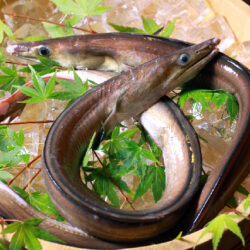
The Hamo Fish Course.
The theme for July is the Hamo Fish Course.
An indispensable summer dish in Kyoto, hamo (pike conger) is widely enjoyed as a seasonal taste from early summer onward.
The fish is said to grow up drinking the waters of the rainy season, and reaches its peak season around the time of the Gion Festival, at the end of the rainy season.
Because of its many small bones, hamo cannot be eaten as it is. A cooking method called "bone cutting" is used. Hamo bone cutting is a showcase for the skills of a Kyoto cuisine chef, even appearing in an expression proclaiming the task to be a test of mastery. A true chef is said to be able to place the blade so as to cut 26 bones every three centimeters.
Yamashiroya Shozo carefully performs filleting and bone cutting for each and every hamo sent directly from the producing area in Oita Prefecture. We invite you to enjoy the Hamo Course, featuring an assortment of seasonal hamo throughout.
We also have a large selection of specially imported Italian wines to accompany our dishes and offer takeout and delivery menus. We believe you will find our restaurant to be an ideal location for dining with friends, family or colleagues.
We look forward to your visit.
------------------------------------------------------------------------------
The Hamo Fish Course
Sakizuke:
Fried Hamo fish marinated in spicy vinegar sauce
Wan-mono:
Cold bonito-based soup with grated tomato and green soy beans
Hassun:
Fresh asparagus topped with fermented bonito and cream cheese
Salted oriental melon with tapenade and olive oil
Minced Hamo inserted in Manganji pepper
Deep-fried Hamo bones
Hamo roe salted with bell pepper
Zucchini pickled in rice bran
Soy -braised pork with mashed potatoes
Agemono:
Deep-fried Hamo and Hamo based starch soup
Kuchinaoshi:
Soy milk sorbet with beet
Main dish:
Roasted Magrets duck and deep-fried Kamo eggplant, served with soy sauce and olive oil
Shokuji:
Steamed rice with grilled Hamo and corns
Red miso soup with mozzarella cheese
Dessert:
Hoji-tea ice cream
Pumpkin cake
Sweet and spicy tomato
-
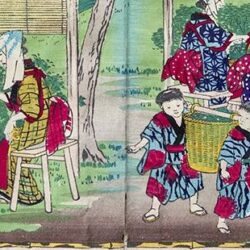
The 118th Night.
June’s theme is The 118th Night.
At Yamashiroya Shozo, we had planned our May menu around the theme The 88th Night of Spring, but had to suspend business due to the state of emergency declaration. We are approaching June full of regret without having been able to present our 88th Night menu to you all even once. For that reason, although it is a month late, we are delighted to offer you our 88th Night menu in June, restyled 30 days later as The 118th Night. We eagerly look forward to sharing the joy of eating out with you.
We also have a large selection of specially imported Italian wines to accompany our dishes and offer takeout and delivery menus. We believe you will find our restaurant to be an ideal location for dining with friends, family or colleagues.
We look forward to your visit.
------------------------------------------------------------------------------
The one hundred eighteenth night
Sakizuke:
Soba noodle with green powdered tea topped with peanut sauce
Wan-mono:
Bonito and broad beans-based soup with scallop ball and wasabi cream sauce
Hassun:
Green tea and sesame tofu
Green maple leaf tempura
Taranome kinpira with Chinese chili bean sauce
Asparagus with black sesame sauce
Boiled octopus mixed with Saikyo miso
Red cabbage and shrimp mixed with cream cheese
Pickled young corn in rice bran
Nimono:
Deep-fried Ainame fish and eggplant served with bonito-based soup and grated cucumber vinegar
Kuchinaoshi:
Shochu with green tea sorbet
Main dish:
Boiled chamiton pork and mashed potatoes wrapped in fresh magnolia leaf
Shokuji:
Ochazuke with roasted rice and deep-fried horse mackerel
Dessert:
Hoji-tea ice cream
Sweet bean jelly with earl grey tea
Bean ball with green powdered tea
-

The eighty eighth night
The theme for May is The Eighty eighth Night. The Eighty-eighth Night is the eighty eighth day after Risshun, the beginning of spring. This is the time when spring becomes summer, and weather becomes warm and mild; it marks the beginning of the season for sowing rice seeds and picking tea. There is a saying that if you drink fresh with fresh tea leaves harvested on the eighty eighth night, you can ward off illness. We have therefore included plenty of tea related ingredients in this month’s menu.
Try the fragrant tea soba noodles served with a peanut sauce for an appetizer. Next, enjoy the fragrance of tea with tea sesame tofu and fresh tea leaf bud tempura. For the main dish, we have Chamiton pork from Kagoshima, made using pigs raised on a diet of tea leaves. The Chamiton pork is cooked in hojicha, wrapped in fresh magnolia leaf, and steamed with fresh grated potatoes. Take the opportunity to enjoy Yamashiroya Shozo's unique Kyoto Kuzushi Kappou (avant garde Kyoto cuisine) made using tea related ingredients.
We also have a large selection of specially imported Italian wines to accompany our dishes and offer takeout and delivery menus. We believe you will find our restaurant to be an ideal location for dining with friends, family or colleagues.
We look forward to your visit.
------------------------------------------------------------------------------
The eighty eighth night
Sakizuke:
Soba noodle with green powdered tea topped with peanut sauce
Wan-mono:
Bonito and broad beans-based soup with scallop ball and wasabi cream sauce
Hassun:
Green tea and sesame tofu
The first tea leaf bud tempura
Taranome kinpira with Chinese chili bean sauce
Asparagus with black sesame sauce
Boiled octopus mixed with Saikyo miso
Spring cabbage and shrimp mixed with cream cheese
Pickled young corn in rice bran
Nimono:
Deep-fried Ainame fish and eggplant served with bonito-based soup and grated cucumber vinegar
Kuchinaoshi:
Shochu with green tea sorbet
Main dish:
Boiled chamiton pork and mashed potatoes wrapped in fresh magnolia leaf
Shokuji:
Ochazuke with roasted rice and deep-fried horse mackerel
Dessert:
Hoji-tea ice cream
Sweet bean jelly with earl grey tea
Bean ball with green powdered tea
-

Cherry Blossom Viewing
The theme for April’s recipes is “Hanami”. “Hanami”—watching cherry blossoms to celebrate the coming of spring—is one of Japan’s oldest traditions.
Cherry blossoms or sakura fall off the tree branches after blooming in just 2 short weeks, and the beautiful scenery of the flowers fluttering in the wind is often likened to how fragile life is.
This month’s course starts from mini plate appetizers that resemble lunchboxes for hanami picnics. The mini plates contain hanami dumplings and Kyoto egg sandwich with savory rolled omelletes, made to resemble lunchbox items. Next, we have bamboo shoot soup, a typical seasonal ingredient in spring. To allow you to enjoy lots of rice wine during your hanami, turmeric is mixed into the soup stock, making it an alcohol detox. The main dish is horse meat. Horse meat is also called sakura meat, making it the perfect meat for this season. Other than that, the dishes are also sprinkled with sakura petals.
Please savor your meal as if you were at a hanami picnic at Yamashiroya Shozo.
Enjoy a unique “neo-Kyoto haute cuisine” at Yamashiroya Shozo.
We also have a large selection of specially imported Italian wines to accompany our dishes and offer takeout and delivery menus. We believe you will find our restaurant to be an ideal location for dining with friends, family or colleagues.
We look forward to your visit.
------------------------------------------------------------------------------
Sakizuke:
Dumplings
Egg yolk pickled in rice bran
Konnyaku ball simmered in soy sauce
Duck meat ball simmered teriyaki sauce
Blowfish skin pink jelly
Arch shell and asparagus mixed with walnuts and miso
Egg sandwich alla Kyoto
Wan-mono:
Spicy bonito-based soup with bamboo shoots and seaweed
Oshinogi:
Sea bream sushi wrapped in a leaf of cherry blossom
Agemono:
Fresh bonito cutlet served with ponzu sauce
Kuchinaoshi:
Cherry blossom sorbet
Main dish:
Horse sashimi tartar served with four kinds of sauce
Shokuji:
Grilled Spanish mackerel with saikyo miso rice bowl
Tomewan:
Bonito-based soup with dried shrimp tempura
Dessert:
Hoji-tea ice cream
Bean ball with cherry blossoms and cheese
Dorayaki with strawberry
-
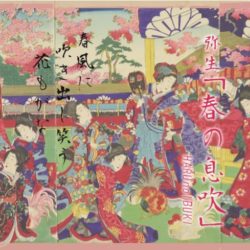
Breath of Spring
The theme of our March menu is "Breath of Spring". The Breath of Spring is what makes us feel the arrival of spring, and the life that it brings. As this is being written, in February, it is still cold, but the first breath of spring has come, and we are starting to see warmer days. Spring is already around the corner.
The end of winter is expressed with our Deep-fried Bamboo Shoots with Coconut and Lingering Snow Espuma, an appetizer that has become a staple in the Breath of Spring, and brings anticipation for spring's arrival. It is the beginning of the course. In the bowls and simmered dishes, the warmth of spring is expressed by our cherry-red soup and bean paste, and the wild vegetables used throughout the course give you a sense of the strength of life.
Visit Yamashiro-ya Shozo and try our original Kyoto Kuzushi cuisine.
We also have a large selection of specially imported Italian wines to accompany our dishes and offer takeout and delivery menus. We believe you will find our restaurant to be an ideal location for dining with friends, family or colleagues.
We look forward to your visit.
------------------------------------------------------------------------------
Sakizuke:
Deep-fried bamboo shoots with coconuts and Japanese pepper foam
Wan-mono:
Bonito-based miso soup with minced calm ball and water cress
Hassun:
Spicy boiled fire fly squid
Small fish with beaten egg and cumin
Taranome pickled in rice bran tempura
Marinated spring onions in plum vinegar
Rolled sushi with rape blossom and jelly fish
Marinated Udo in miso
Grated Japanese parsley soup
Mushimono:
Steamed salmon trout, clams, autumn poem topped with pink milk starch
Kuchinaoshi:
Yuzu flavored ricotta cheese with rice cracker
Main dish:
Pork loin cullet flavored with truffle
Shokuji:
Seafood chirashi sushi
Tomewan
Red miso soup with deep-fried Japanese butterbur
Dessert:
Hoji-tea ice cream
Amazake mousse
White chocolate with rice cracker -
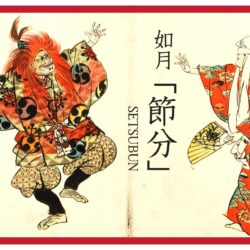
Setsubun(bean-throwing day)
February’s menu theme is “Setsubun.” “Setsubun” once refered to the day before the beginning of spring, summer, autumn, or winter. In Japan’s lunar calendar, the new year began in the spring, so Setsubun, the day before the beginning of spring, was an important day, and was the equivalent of New Year's Eve. Therefore, the Setsubun before spring was considered important, and the word Setsubun came to refer to this day. The well known bean-throwing ceremony is an event to purge evil spirits to welcome the New Year as well.
We use seasonal ingredients and traditional culinary techniques to prepare the unique “Kyo-kuzushi kappo” of Yamashiroya.
We also have a large selection of specially imported Italian wines to accompany our dishes and offer takeout and delivery menus. We believe you will find our restaurant to be an ideal location for dining with friends, family or colleagues.
We look forward to your visit.
------------------------------------------------------------------------------
Sakizuke:
Non traditional “Lucky direction roll”
Wan-mono:
Kenchin-jiru soup with deep-fried tofu mixed with some sliced vegetables
Hassun:
Roasted soy beans
Sardine boiled in sweetened and soy sauce with poppy seeds
Spicy konjac
Pickled broccoli in rice bran
Plum-flavored gluten
Grilled bamboo shoots with herbs
Kumquat cooked with honey and pear
Nimono:
Sea bream and Kyoto radish cooked in bonito-based soup with curry flavor
Kuchinaoshi:
Yuzu flavored ricotta cheese with rice cracker
Main dish:
Whale meat sashimi marinated in Saikyo miso,
served with fried buckwheat noodles and mustards sauce
Shokuji:
Ochazuke with salted plum, sed kelp, rice cracker and blowfish
Dessert:
Hoji-tea ice cream
Good luck in!
Red wine agar jelly
-
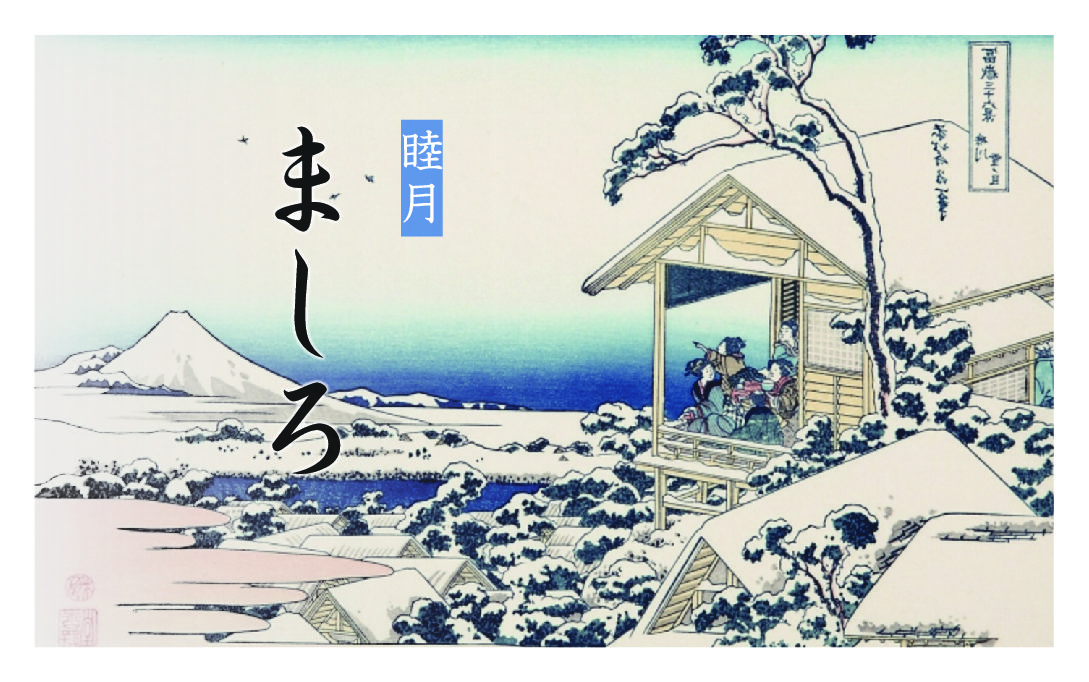
Pure White
The theme for the January meal plan is “Pure White”. While we are entering the coldest and harshest season of the year, this is also the only season during which we are graced with the beautiful landscape after a snowfall.
The colors of the meals in the plan are also made to be “white” so that it will be a feast for the eyes as well. As was written by Yutaka Hara in a haiku poem, “Roast some mochi, and turn over the leaf to a new year”, let’s reflect on the previous year and look ahead to the new year with renewed hopes and resolutions. We use seasonal ingredients and traditional culinary techniques to prepare the unique “Kyo-kuzushi kappo” of Yamashiroya.
We also have a large selection of specially imported Italian wines to accompany our dishes and offer takeout and delivery menus. We believe you will find our restaurant to be an ideal location for dining with friends, family or colleagues.
We look forward to your visit.
------------------------------------------------------------------------------
Sakizuke:
Pickled mackerel sandwich with white celery
Wan-mono:
Bonito and milk Kuzu starch soup with soft cod roe
Hassun:
Pickled cauliflower in rice bran
Maitake mushroom salad dressed with tofu paste
Leek mixed with yam and quail egg
Creamed soup with lily bulb
Boiled burdock mixed with spicy cod roe
Marinated boiled Japanese pond smelt
Seared scallop with salted bonito guts
Agemono:
Deep-fried stuffed lotus root and foie gras
Kuchinaoshi:
Ricotta cheese with organic yuzu citron
Main dish:
Beef tongue in chicken-based soup served with boiled organic mandarin
Shokuji:
Cooked rice with fresh peppers
Tomewan:
Red miso soup with mascarpone
Dessert:
Hoji-tea ice cream
Steamed yam bun
Bean ball with mashed potatoes
-
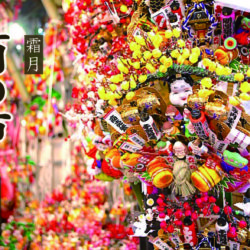
Torino-Ichi(Poultry Fair)
Our theme for November’s menu is Torino-Ichi. Taking place upon each day of the rooster in November, Torino-Ichi (Poultry Fair) is a festival where people pray for good fortune and prosperity. Celebrated at Otori-jinja shrines across the Kanto region, the festival dates back to the Edo period, and was even featured in classic ukiyo-e prints and Ichiyo Higuchi’s novella“Takekurabe”.
Participants in the festival buy special good luck charms known as engi-kumade (lucky rakes), and pray for wealth and prosperity in the coming year. These engi-kumade are said to “rake in fortune” and “sweep up blessings”. They are also bought to “snatch up good fortune”, and for this purpose they mimic the talons of an eagle (washi), a reference to the Japanese verb washitsugamu, meaning to snatch or grab.
Additionally, charms of different sizes are sold, and there is a custom of buying one size bigger than you bought the previous year, in the hopes that the coming year will be more prosperous than the previous one.
At Yamashiro Shozo this month, we are drawing upon this ancient and wonderful cultural tradition, and interpreting it through our unique “Kyo-kuzushi kappo”.
We also have a large selection of specially imported Italian wines to accompany our dishes and offer takeout and delivery menus. We believe you will find our restaurant to be an ideal location for dining with friends, family or colleagues.
We look forward to your visit.
------------------------------------------------------------------------------
Sakizuke & Hassun:
Red konnyaku cooked in bonito-based soup
Steamed shrimp ball
Sweet and spicy quail egg
Daikon pickled in salted rice yeast
Sweet potato Mochi with foie gras
Sweetened mochi flavored with Japanese pepper
Wan-mono:
Bonito and pumpkin-based soup with Maqre duck meatball
Otsukuri:
Amberjack sashimi served with sake and Yuzu
Agemono:
Yam tempura and conger eel tempura, served with miso and mascarpone
Kuchinaoshi:
Pickled tofu in rice bran with dried seaweed
Main dish:
Horse tataki served with avocado sauce
Shokuji:
Squid ink flavored Ochazuke with minced chicken
Dessert:
Hoji-tea ice cream
Persimmon mousse
Bean ball with chestnut
-
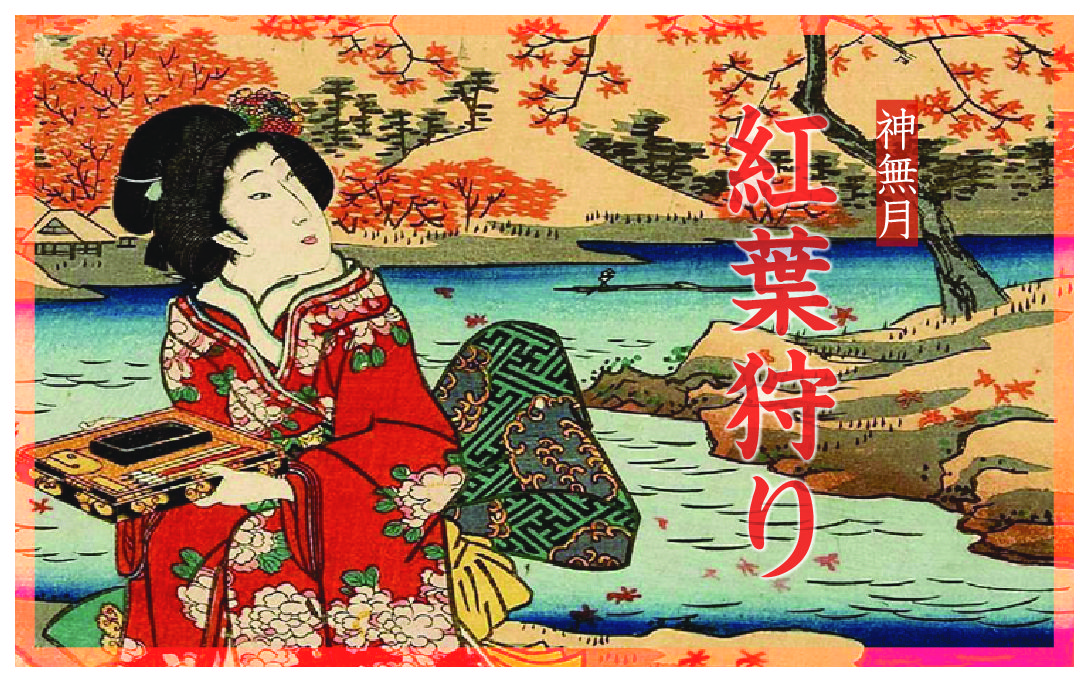
Red Maple Leaf Hunting
The theme for October’s menu is “Red Maple Leaf Hunting.” Aristocrats of the Heian period admired many flowers such as cherry and wisteria blossoms, but in point of fact, autumn maple leaves are rarely mentioned. Cherry trees were planted in the Imperial Palace and at the estates of the aristocracy, but enjoying the autumn colors required an excursion to the mountains. Originally, the same word used for hunting animals was used to refer to the activity, as Heian aristocrats used to say jokingly that they were going hunting when they went to appreciate the autumn leaves.
We created a menu based on this time-honored culture of autumn foliage viewing, with dishes that evoke the imagery of red autumn leaves. Please enjoy Yamashiroya Shozo’s unique interpretation of innovative Kyoto cuisine.
We also have a large selection of specially imported Italian wines to accompany our dishes and offer takeout and delivery menus. We believe you will find our restaurant to be an ideal location for dining with friends, family or colleagues.
We look forward to your visit.
------------------------------------------------------------------------------
Sakizuke:
Scorched saury, apple and cumin mixed with sweet vinegar
Wan-mono:
Bonito based soup with grated potato and minced venison ball
Hassun:
Half raw sea bream preserved in seaweed
Scorched sweet chestnut
Ginkgo nut in perilla oil
Deep-fried gluten cake sandwich with Tapenade
Fresh yuba mixed with mascarpone cheese
Salted Hamo fish roe with Yuzu citron
Agemono:
Deep-fried bonito and turnip served with bonito-based soup starch
Kuchinaoshi:
Pickled tofu in rice bran with dried seaweed
Main dish:
Steamed pork and dried persimmon mixed with tofu and miso
Shokuji:
Rice cooked in tomato-based soup with grilled Hamo fish
Tomewan:
Bonito-based soup with deep-fried Hamo liver
Dessert:
Hoji-tea ice cream
Sangria jelly with pear
Black sesame ball
-
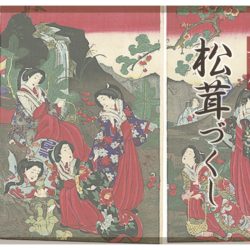
All Matsutake Mushrooms
The concept of the September menu is ”All Matsutake Mushrooms.” Matsutake mushrooms and other mushrooms are mentioned in old historical Japanese texts such as The Nihon Shoki/The Chronicles of Japan and Manyoshu. The Kokin Wakashū (an anthology of Japanese waka poetry) written during the Heian period has poems about how aristocrats enjoyed matsutake mushroom hunting as a seasonal event. There is a saying, “Matsutake mushrooms smell excellent, and Shimeji mushrooms taste excellent,” which shows how Matsutake mushrooms have great smells. Therefore, it is often eaten to bring out the smells in menus like “matsutake mushroom and Japanese broth steamed in a teapot” as well as “matsutake rice.” However, they continue to be difficult to artificially cultivate, and the produced amount is declining each year. It has become an expensive ingredient just for enjoying the fragrance.
Plenty of these matsutake mushrooms that smell excellent were used to express Yamashiroyashozo’s original “Innovative Kyoto Cuisine.”
We also have a large selection of specially imported Italian wines to accompany our dishes and offer takeout and delivery menus. We believe you will find our restaurant to be an ideal location for dining with friends, family or colleagues.
We look forward to your visit.
------------------------------------------------------------------------------
Sakizuke:
Matsutake mushrooms and sea bream sashimi
Wan-mono:
Foamed bonito-based soup with lotus mochi and Yuzu pepper
Hassun:
Sliced Hamo and purple chrysanthemums mixed with vinegar
Chinese lantern
Deep-fried Enoki mushrooms
Shimeji mushrooms boiled in miso and soy sauce
Hamo roe jelly
Salmon roe and olive oil drops
Mushimono:
Hamo, matsutake mushrooms and steamed rice served with spicy Kuzu starch sauce
Kuchinaoshi:
Celery sorbet
Main dish:
Sliced cinfit de magret canard, steamed matsutake mushrooms and scorched fig
Shokuji:
Steamed rice with matsutake mushrooms and shallot
Tomewan:
Red miso soup with deep-fried pumpkin
Desset:
Hoji-tea ice cream
Bean ball with purple potatoes
tiramisu with tofu
-
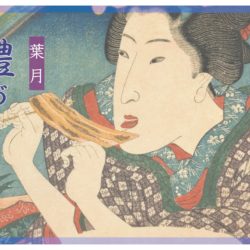
Hamo-centric Dishes Part.2
As a continuation from our July menu, our August menu is “Hamo-centric Dishes Part 2.” In August, as in July, we are getting fresh Hamo (Daggertooth pike conger) air-flown from Oita’s Kitsuki City, carefully cut them in-store, and debone them. We make broth from the Hamo bones we get while deboning them by boiling them for 5 hours, and the broth is also used to full extent in all the dishes. In particular, it is used for the main course, “Hamo Shabu Plan,” in which each serving comes with a personal shabu-shabu hotpot and is a must-try. Organic red onions and hearty maitake mushrooms, from Oita as well, are served together on the side. Don’t be fooled by the simple cooking method, as the broth may be light but combined with the rich and potent “Hamo”, it will blow you away.
Our August menu, “Hamo-centric Dishes Part 2.” As we did in July, we will continue to use fresh Hamo to its full potential to serve you our original “Kyoto Deconstructed Fine Dining.”
We also have a large selection of specially imported Italian wines to accompany our dishes and offer takeout and delivery menus. We believe you will find our restaurant to be an ideal location for dining with friends, family or colleagues.
We look forward to your visit.
------------------------------------------------------------------------------
Sakizuke:
Grilled Hamo fish and mayonnaise with satsuma mandarin sauce
Wan-mono:
Shrimp dumpling and coriander in fermented fish soy sauce
Hassun:
Steamed Hamo sushi with Japanese pepper
Pickled young ginger with cloves
Boiled Hamo roe cooked with curry powder
Deep-fried Hamo bones
Zucchini pickled in bran
Young plum pickled in sweet sauce
Hamo and cucumber mixed with sweet vinegar
Nimono:
Boiled Hamo with tomato juice and vegetables served with tomato miso sauce
Kuchinaoshi:
Celery sorbet
Main dish:
Steamed chicken in fermented fish soy sauce
Shokuji:
Tendon topped with Hamo tempura
Tomewan
Red miso soup with Hamo fish bladder
Dessert:
Hoji-tea ice cream
Sweet bean jelly with Shikwasa
Kuzu starch noodle with jasmine sweet sauce
-
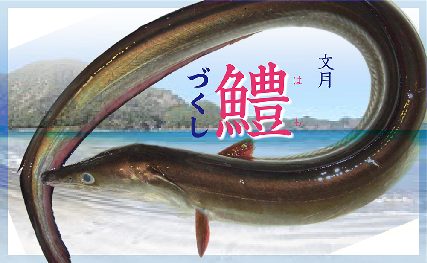
Hamo zukushi
The theme of our July menu will be “Hamozukushi.” Hamo (pike conger) may be a fish unfamiliar to people living in eastern Japan, but in the Kansai region and especially in Kyoto, it is an ingredient that has been well-loved and often enjoyed since ancient times.
In our hope to allow as many people in Tokyo as possible to conveniently enjoy the taste of hamo, we have been procuring fresh hamo from Kitsuki City in Oita prefecture with which we share deep affinities. The fish is shipped to us by air and carefully prepared at our restaurant.
The dashi stock is made by extracting the flavors from the hamo bones recovered during our preparation of the fish over the course of five hours, and it features prominently in our menu. In particular, for the “Hamo-shabu Plan” whose main dish is hamo-shabu, every guest will be served this delicious stock as a shabu-shabu base.
We use organic red onions as well as meaty Maitake mushrooms sourced from Oita prefecture for the garnish.
Enjoy the subtle but powerfully memorable flavors unique to hamo that has been prepared using our simple culinary techniques.
This “Hamozukushi” will be available in July. We will continue to use seasonal ingredients based on the prevailing theme to showcase our restaurant’s unique take on “Kyo-kuzushi kappo.”
We also have a large selection of specially imported Italian wines to accompany our dishes and offer takeout and delivery menus. We believe you will find our restaurant to be an ideal location for dining with friends, family or colleagues.
We look forward to your visit.
------------------------------------------------------------------------------
Sakizuke:
Sesame tofu with satsuma mandarin sauce
Wan-mono:
Grilled Hamo fish with tomato-based soup
Hassun:
Steamed Hamo sushi with Japanese pepper
Boiled Hamo roe with vegetables
Deep-fried Hamo bones
Minced octopus ball with basil jelly sauce
Pumpkin pickled in rice bran
New sweet potatoes cooked in brandy
Green tomato flavored with orange liqueur
Age-mono:
Hamo tempura with spicy salt and served with pickled plum
Kuchinaoshi:
Celery sorbet
Main dish:
Pork cutlet topped with dried egg yolk and minced yam
Shokuji:
Hamo ochazuke in Hamo soup-base, served with Japanese rice crackers
Dessert:
Hoji-tea ice cream
Rice-flour dumplings and Dragon fruits
Pudding with green soybeans
-
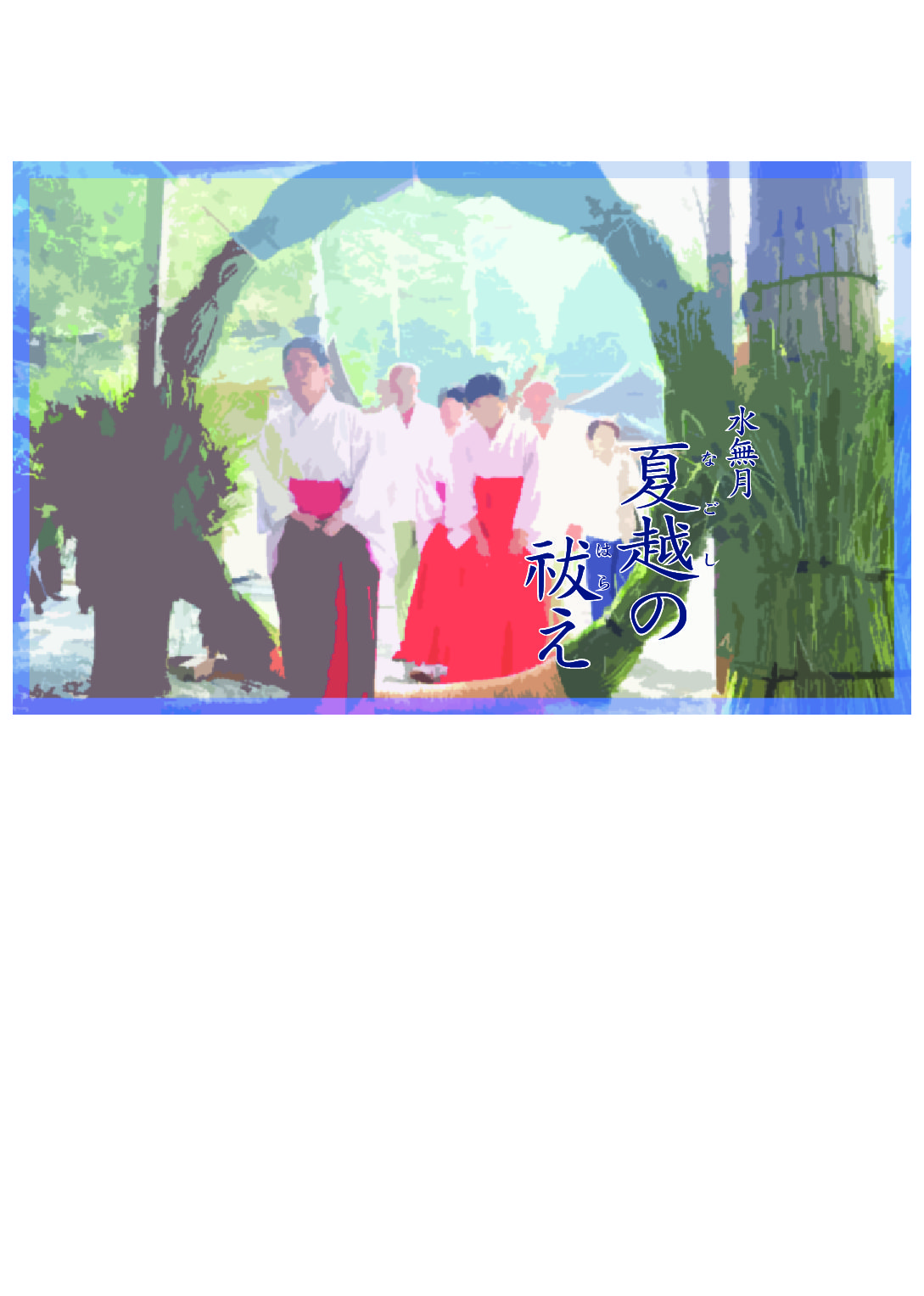
Summer Purification Rites
The theme for the June menu is ‘Summer Purification Rites (Nagoshi no Harae)’. At the event held on June 30th, people pass through a cogon grass ring built in the shrine grounds in order to rid themselves of sins and impurities. This ritual is also known as ‘Chinowa-kuguri’. Chinowa refers to a ring (wa) woven from cogon grass (chigaya).
The origin of this traditional event can be traced back to the purification ritual of the creator deity Izanagi. It is still held at shrines all over Japan around June 30th, even though we have moved to the Gregorian calendar.
In accordance with the theme of ‘Summer Purification Rites’, we present our restaurant ‘Kyoto Kuzushi Kappo’, which uses seasonal ingredients.
We also have a large selection of specially imported Italian wines to accompany our dishes and offer takeout and delivery menus. We believe you will find our restaurant to be an ideal location for dining with friends, family or colleagues.
We look forward to your visit.
------------------------------------------------------------------------------
Sakizuke:
Sesame paste stiffened with Kuzu starch
Wan-mono:
Grated broad beans in bonito-based soup with deep-fried fat greenling
Hassun:
Deep-fried young sweet fish with salt and herbs
Stir-fried green soy beans with garlic
Cold corn pudding
Pickled sugar snap pea in rice bran
Pickled mozzarella in rice bran and miso
Stir-fried burdock with salty and sweet sauce
Deep-fried shallot with vinegar miso
Agemono:
Bonito tataki cutlet
Kuchinaoshi:
Celery and sake sorbet
Main dish:
Horse tataki served with roquette sauce
Shokuji:
Eel Chirashi sushi
Tomewan:
Red miso soup with deep-fried eggplant
Dessert:
Hoji-tea ice cream
Sake lees mousse
Pineapple pickled in plum wine
-

Setsubun(bean-throwing day)
Our theme for the month of February is “Setsubun.” Setsubun refers to the days before the seasonal turning points of the first days of spring, summer, autumn, and winter. Setsubun thus occurs four times a year. However, in the Japanese lunar calendar, the new year starts in the spring, so the Setsubun that occurs the day before spring starts (February 3rd) is a very important day similar to New Year’s Eve. Therefore, importance is placed on this Setsubun in particular, and “Setsubun” in general now mainly refers to this day.
In the past, during the turning points of the seasons, and particularly during the turning points between the old and the new year, it was thought that evil spirits could enter more easily, and many rituals to get rid of these spirits took place. The act of scattering parched beans, which all Japanese people are familiar with, is an example of a ritual to get rid of evil spirits to welcome the new year.
At Yamashiroya Shozo, we utilize seasonal materials in accordance with each month’s theme and express an original “Kyo kuzushi Kappo.”
Furthermore, we always import many varieties of Italian wine that fit with our menu, so you can always find yourself satisfied no matter the occasion, be it a company gathering or enjoying time with family and friends. We always keep our restaurant warm in anticipation of our guests.
------------------------------------------------------------------------------
Sakizuke:
Non traditional“Lucky direction roll”
Wan-mono:
Bonito-based soup with grated Kyoto radish and chia seeds, blowfish and ginkgo nuts
Hassun:
Roasted soy beans
Deep-fried sardine with rice crackers
Raw sea bream mixed with grated green soybeans
Spicy konnyaku
Pickled broccoli in rice bran
Spicy crab flakes
Roasted bamboo shoot with various herbs
Nimono:
Kyoto radish and sea bream cooked in bonito-based soup with curry flavor
Kuchinaoshi:
Scorched mozzarella with miso and vinegar
Main dish:
Raw whale tataki and mustard soy sauce served with fried buckwheat noodles
Shokuji:
Home-made fermented sardine Ochazuke with fresh seaweed
Dessert:
Hoji-tea ice cream
Good luck in !
White bean ball -

The Whiteness of New Year
The theme for January’s menu is “The Whiteness of New Year” It is the coldest it has been this season, and it keeps getting colder, but the winter scenery after snow has just fallen is a beautiful sight that can only be seen during this time of year.
Our menu items are centered around the color “white” in line with January’s theme, and are quite a sight for the eyes.
Yutaka Hara’s haiku goes as follows: “Grill a few mochi, welcome in the brand new year, turning back around.” Let us look back on the last twelve months as we nurture our wishes and goals for the new year.
We are keeping our restaurant warm for your arrival.
------------------------------------------------------------------------------
Sakizuke:
Squid sushi with strawberry
Wanmono:
Bonito and milk Kuzu starch soup with cod roe
Hassun:
Pickled tofu in miso
Leek mixed with yam and quail egg
Rape blossoms mixed with mustard topped by thinly-sliced radish
Pickled cauliflower in rice bran
Boiled burdock root mixed with spicy cod roe
Creamed soup with lily bulb
Deep-fried lake smelt with spelt wheat
Agemono:
Scallop-cream croquette with porcini mushroom
Kuchinaoshi:
Cream cheese mixed with bonito flakes served with seaweed
Syusai:
Tsukune with quail egg in chicken broth
Shokuji:
Ochazuke a la carbonara with fresh pepper
Dessert:
Hoji-tea ice cream
Agar jelly with dried orange
Coffee and vanilla castella sponge cake
-
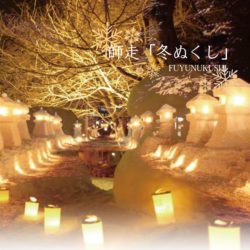
The Warm Days of Winter
Similar to the Indian Summer of autumn, we have some warm days during winter.
December is a very busy month with many year-end parties and preparing for the New Year. Remaining healthy for such activities is very important.
We have created a menu with various seasonal ingredients which will offer you highly nutritional dishes and bring body warmth.
We hope you will enjoy the “winter warmth” as well as the festivities of this season.
Selected wines of December
*3 di NOTTE VINO SPUMANTE BRUT
*FIANO DI AVELLINO SIGNIFER D.O.C.G.
*CAMPANIA AGLIANICO I.G.P.
------------------------------------------------------------------------------
Sakizuke: San Marino ham with egg yolk foam
Wan-mono: Bonito-based soup with anglerfish liver, Chinese cabbage and spicy miso
Hassun: Kyoto carrot and white celery mixed with olive oil and Japanese pepper
Red Konnyaku pickled in rice bran
Stir-fried organic green papaya with soy sauce and sugar
Steamed foie gras with citrus vinegar
Bonito-based simmered Japanese radish with beets and miso
Seaweed with herring roe soaked in bonito-based soup
Nimono: Cooked yellowtail and Kyoto yam with grated La France pear
Kuchinaoshi: Cream cheese mixed with bonito flakes served with seaweed
Main dish: Pork tempura covered with cheese sauce
Shokuji: Spicy Ochazuke with soy sauce marinated tuna and olive oil
Dessert: Hoji-tea ice cream
Bean ball and chocolate
Lotus root jelly
-
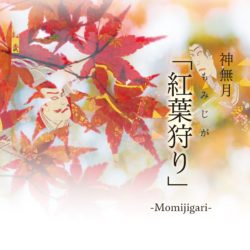
Autumn Leaves
The autumn leaves and the Heian Period aristocrats remind us the event in the Tale of Genji written in the 12th century, in which the main character Hikaru Genji performs the elegant Seigaiha dance.
The Heian Period aristocrats loved various blossoms and flowers such as cherry blossoms and wisteria, but autumn leaves do not appear in the Tale of Genji so often.
This is because cherry trees and others can be planted in the garden of the court, but they had to go to the mountainside to enjoy the autumn leaves. The word “Kari” originally means to hunt the animals, but they used the word to hunt the autumn leaves.
We hope you will enjoy the seasonal menu with the arrival of autumn.
Selected wines of October
*3 di NOTTE VINO SPUMANTE BRUT
*DORO BIANCO GARDA BIANCO D.O.C.
*CHIARETTO VALTENESI CLASSICO D.O.C.
――――――――――――――――――――――――――――――――――
Sakizuke: Round sushi with saury and Foie gras miso
Wan-mono: Bonito-based soup with grated green apple and magret de carand
Hassun: Sweet potato chips and soy milk dip
Chestnuts cooked in coconut milk
Ginko nuts pickled in fermented fish sauce
Stir-fried yam with garlic, soy sauce and butter
Brown mushrooms pickled in rice bran
Hamo fish roe jelly
Swordfish with beated egg
Nimono: Deep-fried tofu mixed with chopped Kyoto yam, covered with crab starch
Kuchinaoshi: Yuzu ricotta cheese with rice cracker
Main dish: Sliced, steamed chicken with Matsutake mushrooms, served with Japanese pickles and cashew nuts
Shokuji: Rice cooked in tomato-based soup with grilled Hamo fish
Tomewan: Bonito-based soup with deep-fried Hamo liver
Dessert: Hoji-tea ice cream
Black sesame ball
Half-dried persimmon with Mirin -

Chrysanthemum Festival
Sakizuke: Sushi with yellow chrysanthemum, grilled Shiitake mushroom and smoked salmon, served with foamed ginger
Wan-mono: Foamed bonito-based soup with lotus mochi and Yuzu pepper
Hassun: Pickled sliced Hamo fish and chrysanthemums
Salmon roe and olive drops
Chinese lantern
Pumpkin pickled in rice bran
Deep-fried Enoki mushrooms
Shimeji mushrooms mixed with miso and seaweed
Rice cracker sandwich with foie gras and sweet beans
Nimono: Steamed Kanpachi fish, radish and Shungiku, covered with sweet and spicy starch
Kuchinaoshi: Pear and celery sorbet
Main dish: Meat dumpling with truffle, served with grated cucumber
Shokuji: Steamed rice with spicy miso and chestnuts
Tomewan: Red miso soup with mozzarella
Dessert: Hoji-tea ice cream
Mushed sweet potato with dried apricot
Cocoa biscotti with Marsala wine -
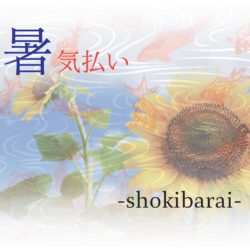
Beating Summer Heat
“Shokibarai” or beating summer heat is the Japanese tradition, to eat cold food or ingredients to cool down the body heat during summer. Not only the food but also the Chinese herbal medicine is used which has the effect to cool down the body heat.
Based on the Chinese herbal medicine, sometimes warm or hot drinks and food were taken.
However, nowadays most people drink cold soft drinks or beer to overcome summer heat, and this tradition has become an excuse to enjoy drinks and food to get rid of summer heat or stress at work.
We hope this month’s menu will give you the power to fight against sever summer heat.
Selected wines of August
*3 di NOTTE VINO SPUMANTE BRUT
*OFFIDA PECORINO D.O.C.G. BIO
*DORIAN EMILIA I.G.T. ROSSO
――――――――――――――――――――――――――――――――――
Sakizuke: Yam soup with abalone and abalone liver soy sauce, served with seaweed
Wan-mono: Shrimp dumpling and coriander in fermented fish soy sauce soup with citrus
Hassun: Soft-shell turtle jelly
Eel, cucumber and white peach mixed with vinegar
Sword fish with soy sauce and egg
Zucchini pickled in rice bran
Young plum pickled in sweet sauce
Stir-fried Goya with deep-fried tofu
Fruit tomato jelly
Nimono: Cold assorted dish; Hamo fish, Okura, spaghetti squash and tomato
Kuchinaoshi: Celery and grape sorbet
Main dish: Stewed pork with Yuba and salty wasabi
Shokuji: Hamao tempura rice bowl with young Yuzu
Tomewan: Red miso soup with Hamo air bladder
Dessert: Hoji-tea ice cream
Fig florentin
Water melon jelly
-

Various Hamo Fish Dishes
Various Hamo Fish Dishes
Hamo fish has not commonly been eaten in the Kanto region, but has been popular with people in Kansai and especially Kyoto. We will serve fresh Hamo fish to Tokyo diners by arranging air shipment of fresh Hamo from Ohita Prefecture for special preparation in our restaurant.
The soup-base is made from Hamo bones, cooking over five hours, which is served as a Shabushabu base. Please enjoy the simple yet delicious dishes
Organic red onions and thick Maitaki mushrooms are served with Hamo fish. We also imported directly Italian wine which add fine flavour to these Japanese dishes.
We hope that this month’s menu will be enjoyed in the company of your family, friends or corporate colleagues.
Selected wines of July
*3 di NOTTE VINO SPUMANTE BRUT
*MARCHE PASSERINA I.G.P.
*VINO ROSSO VERONESE I.G.T. "GODO"
――――――――――――――――――――――――――――――――――
Various Hamo Fish Dishes
Sakizuke: Poached Hamo fish and Junsai in Vichyssoise jelly
Wan-mono: Grilled Hamo fish with tomato-based soup flavored with olive oil
Hassun: Steamed Hamo sushi with Japanese pepper
Cooked Hamo roe with beaten eggs
Deep-fried Hamo bones
Deep-fried Hamo with sesame
Pumpkin pickled in rice bran
New sweet potatoes cooked in brandy
Green tomatoes flavored with orange liquor
Age-mono: Hamo tempura with spicy salt served with pickled plum
Kuchinaoshi: Celery and green grape sorbet
Main dish: Two varieties of horse sashimi with olive oil, served with pickled new onion and raisons
Shokuji: Hamo ochazuke in Hamo soup-base, served with Japanese rice crackers
Dessert: Hoji-tea ice cream
Two jellies, black-tea and peach
Sweet pumpkin Chakin
-

Cleansing of impurities for Summer
At the end of June, there is a traditional ritual to get rid of all impurities from the first half of the year.
This is a wish for health and well-being for the rest of the year. Even today, this ritual can be seen at various shrines around Japan on June 30th.
Our restaurant offers a menu designed for the health of the diner. We hope you will overcome the heat of Summer.
Selected wines of June
*3 di NOTTE VINO SPUMANTE BRUT
*ZIBIBBO I.G.P.
*VALPOLICELLA CLASSICO SUPERIORE D.O.C.
――――――――――――――――――――――――――――――――――
Cleansing of impurities for Summer
Sakizuke: Seared tuna, deep-fried shallot, served with vinegar miso
Wan-mono: Red cabbage and bonito starched milk soup with savory cabbage roll
Hassun: Bracken starch tofu cake with sesame and red beans
Stir-fried green soy beans with garlic
Deep-fried young sweetfish with herbs
Cold corn pudding
Apricot, radish and paprika pickled in sweet vinegar
Chopped raw horse mackerel with pickled plum and miso
Mushi-mono: Chicken and Kiritanpo in fermented fish soy sauce soup with Junsai
Kuchinaoshi: Celery sorbet with Kumin-flavored tomato foam
Main dish: Grilled lamb marinated in Saikyo miso
Round eggplant with miso
Thinly-sliced pickled lotus root and thyme
Shokuji: Eel chirashi sushi
Tomewan: Red miso soup with new ginger pickled in rice bran
Dessert: Hoji-tea ice cream
Sake lees mousse
Pineapple pickled in plum wine
-

Cherry Blossom Viewing
Cherry Blossom Viewing
In Japan the term "blossom viewing" relates to cherry blossom and is custom that dates back for a thousand years. Originally, blossom-viewing was introduced from China at a time when plum blossom viewing was more common in Japan. During the Heian Period, throughout Japan cherry blossom viewing took over. All over Japan, people enjoyed viewing cherry blossom because they are seen as the guardian of rice as when the blossom arrives it is when the spirits tell the people it is time to plant rice. People treasured the spirit of cherry blossom and prayed for a good rice harvest.
For this month's menu, we have incorporated the theme of cherry blossom viewing so that you may enjoy that can be seen as a special lunch box taken with when viewing blossom.
Sakizuke/Hassun is a variety of seasonal vegetables and sea-food. Please enjoy the colors, scents, appearance and flavors.
Wanmono is deep-fried Aburame fish which is an early Spring speciality. It is served with grated new potatoes in a bonito-based soup.
Oshinogi presents a rice ball wrapped in bamboo leaf. The mochi rice is steamed with only salt and sake with bamboo shoots and Tochi inside.
Nimono offers minced shrimp ball with spicy oriental sauce.
The main dish is free-range chicken which is steamed at low temperature in a vacuum pack finished with fermented fish soy sauce, a speciality of Akita Prefecture. Enjoy the soft and tender texture which is quite surprising for chicken.
Shokuji consists of Ochazuke with Yuba and young spring leaves.
Cherry blossom is the major symbol of Japan, when huge crowds visit the many famous places for viewing to enjoy the arrival of Spring. The blossom has a very subtle scent called "coumarin" which helps relaxation and the blossom also affects the five senses with which you will enjoy our menu.
Selected wines of April
*3 di NOTTE VINO SPUMANTE BRUT
*PRATOBIANCO EMILIA I.G.T. BIANCO
*DORIAN EMILIA I.G.T. ROSSO
―――――――――――――――――――――――――――――――――――――
Cherry Blossom Viewing
Sakizuke: Dumplings -
Egg yolk pickled in rice bran
Cooked Konnyaku
Minced chicken ball with chocolate sauce
Blowfish skin jelly
Small squid mixed with peanut butter
Thinly-sliced boiled asparagus
Thinly-sliced dried radish with tomato catsup
Wan-mono: Bonito and potato-based soup with deep-fried Aburame fish
Oshinogi: Rice ball wrapped in bamboo leaf with bamboo shoots and Tochi
Nimono: Minced shrimp ball with oriental sauce and fried rice paper
Kuchinaoshi: Celery and pepper sorbet
Main dish: Steamed chicken in fermented fish soy sauce
Shokuji: Ochazuke with Yuba and young spring leaves
Tomewan: Red miso soup with deep-fried Japanese butterbur
Dessert: Bean ball with cherry blossom flavor
Cheesecake with cherry blossom
Hoji-tea ice cream
-

Setsubun (Bean-throwing day)
Setsubun comes between Winter and Spring, a term according to the traditional Japanese calendar, such as Risshun (beginning of Spring), Rikka (beginning of Summer), Risshu (beginning of Autumn) and Ritto (beginning of Winter). Setsubun is the day before Risshun and also New Year's Eve in the traditional Japanese calendar, when people throw beans to get rid of evil spirits.
Roasted beans were used for bean-throwing events and eaten afterwards to bring well-being.
We have incorporated the theme of "Setsubun" for this month's menu.
Wanmono offers bonito-based soup with grated Kyoto radish and ginko nuts.
Kyoto radish is in season during winter and becomes more sweeter. It is grated to represent snow and placed in the soup with grilled blowfish and ginko nuts and thickened with Kuzu starch.
Hassun is a variety of seasonal dishes such as deep-fried sardine with salt and herbs or plum-flavored gluten. Enjoy their eye-appeal before eating.
Nimono offers Kyoto radish and sea bream cooked in bonito-based soup with curry flavor, quite an unusual combination of ingredients creating an innovative dish.
The main dish is a roasted duck from Shiogama. The duck is roasted with far- infrared heat and served with Shiogama salt. The pickled apple in rice bran is placed diagonally, so that the duck and apple can be tasted separately.
Shokuji presents home-made fermented sardine Ochazuke with fresh seaweed.
At Yamashiroya Shozo we offer a discounted Wine Fair during February. A good chance to experience more expensive wine. We went to various wineries to select and directly import their products and hope that they bring enjoyment with the food.
Selected wines of February
*SPUMANTE BIANCO PROSECCO EXTRA DRY
*VERNACCIA di SAN GIMIGNANO D.O.C.G.
*CAMPANIA AGLIANICO I.G.P.
―――――――――――――――――――――――――――――――――――――
Setsubun (Bean-throwing day)
Sakizuke: Inari-sushi with thyme, served with cheese and basil
Wan-mono: Bonito-based soup with grated Kyoto radish and Chia seeds, blowfish and
ginko nuts
Hassun: Deep-fried sardine with salt and herbs
Plum-flavored gluten
Roasted soy beans
Grilled squid with fermented squid guts
Crab and yam jelly
Lotus root with spicy miso
Cod roe and Shirataki mixed with Japanese pepper
Nimono: Kyoto radish and sea bream cooked in bonito-based soup with curry flavor
Kuchinaoshi: Salt-flavored lemon sorbet with white pepper
Main dish: Steamed salty duck with pickled apple in rice bran
Shokuji: Home-made fermented sardine Ochazuke with fresh seaweed
Dessert: Bean ball with Okara and cacao nibu
Tofu donut
Hoji-tea ice cream
-

Breath of Spring
Breath of Spring
The long winter is finally coming to its end when March arrives. However, the Japanese Archipelago stretches from below Arctic to subtropical, so the arrival of Spring varies across the nation and so does the variations of Spring. In recent years we also receive the unpleasant effects of pollen allergy or hay fever.
We have used the theme of "Breath of Spring" for this month's menu to express the joy of a long-awaited Spring to rural and urban areas.
Sakizuke is deep-fried bamboo shoots with rice crackers. These bamboo shoots are precious in early Spring. They are served with Japanese pepper foam, representing remaining snow.
Wanmono offers bonito-based soup with sesame tofu, clam and coconut milk.
The sesame tofu is made from sesame paste and Kuzu starch. Enjoy the combination of this tofu and clam as well as the added flavor of the coconut milk.
We have used various wild herbs for Hassun which arrive with the true coming of Spring.
Nimono presents poached salmon trout, clams and rape blossoms topped with pink milk starch to express the new excitement of Spring.
The main dish is steamed Chaminton pork, a brand of pork from Kagoshima that is fed tea leaves and does not have strong odor, which is served with Yuzu miso and adds the freshness of citrus fruit.
It seems that the best time of Spring is in the early morning, as written down in old Japanese and Chinese classic poems and essays.
The long Winter is about to close as Spring arrives around the corner.
Please pay us a visit to savor this fresh breath of Spring.
Selected wines of March
*SPUMANTE BIANCO PROSECCO EXTRA DRY
*IRPINIA FALANGHINA D.O.C.
*VALPOLICELLA CLASSICO SUPERIORE D.O.
ーーーーーーーーーーーーーーーーーーーーーーーーーーーーーーーーーーーーーーーーーーー
Breath of Spring
Sakizuke: Deep-fried bamboo shoots with rice crackers and Japanese pepper foam
Wan-mono: Bonito-based soup with sesame, tofu, clam and coconut milk
Hassun: Dried herring pickled in Sochu and soy sauce
Caramelized small fish, walnuts and coconut flakes
Taranome tempura with trifle salt
Japanese wild herbs pickled in rice bran
Marinated Udo in miso
Boiled Shungiku and Enoki mushrooms
Small fish mixed with miso and egg yolk
Nimono: Poached salmon trout, clams and rape blossoms topped with pink milk starch
Kuchinaoshi: Celery and pepper sorbet
Main dish: Steamed Chaminton pork with Yuzu miso served with spicy Udo
Shokuji: Seafood Chirashi sushi
Tomewan: Red miso soup with deep-fried Japanese butterbur
Dessert: Cooked apple in red wine
Kiwi fruit, strawberry and peach jelly
Hoji-tea ice cream
ACCESS
お気軽にお問い合わせください。
- - TEL -
-
03-5489-0039
03-5489-0039
受付時間 年中無休 - - 営業時間 -
- 12:00~23:00(フードL.O21:30 ドリンクL.O22:30)
- 東京都渋谷区道玄坂2-6-4 2F
